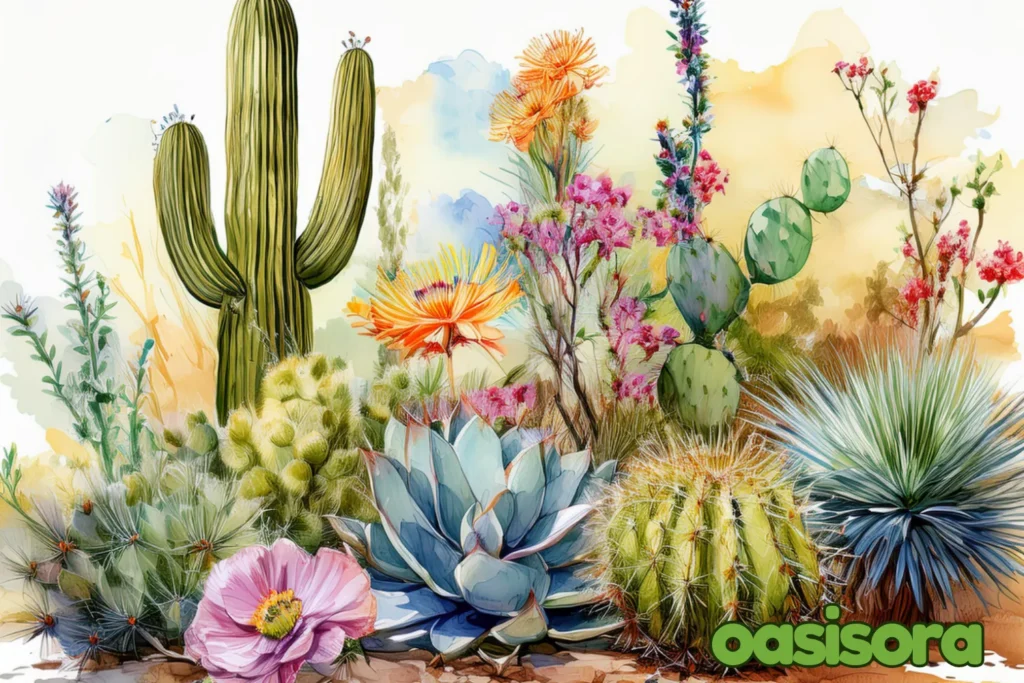
Imagine owning a splendid and low-maintenance desert yard that prospers well in the harsh desert conditions. Yes, of course my folks! It’s the native desert plants. As people try to save water and make sustainable choices, more gardeners in the desert are finding native desert plants. These plants are super strong and can live in tough conditions without much water.
They love being in the hot sun, dry soil, and getting very little water. That’s because, over time, they’ve learned to survive with special tricks like deep roots and waxy leaves. Native plants not only save water but also welcome local butterflies, bees, and birds, creating a joyful home for wildlife in your garden. Here’s everything you need to know about choosing, growing, and enjoying native desert plants in your garden. So, let’s get started now!
TL; DR:
Why Native Desert Plants Are a Must-Have
- These plants can survive with very little water.
- Help local animals like birds, bees, and butterflies.
- Desert plants make your yard look beautiful and unique.
- They don’t require much upkeep or attention.
- Native desert plants contribute to the durability and vitality of the desert ecosystem.
Understanding Native Desert Regions and Plant Adaptations
The United States has four big desert areas: Great Basin, Mojave, Sonoran, and Chihuahuan. Each desert is unique, with different plants and weather. For instance, there are Joshua trees in the Mojave Desert and saguaros in the Sonoran Desert. If you’re curious about the types of trees that thrive in Arizona’s deserts, check out Native Trees for Arizona for more insights.
1. Desert Plant Adaptations
Deserts are very hot and dry, with strong winds and not much rain. The soil is also very poor. Desert plants are special. They have deep roots to find water, shiny leaves to reflect the sun, and thick skins to store water.
2. Microhabitat Considerations
Where you plant something in the desert matters a lot. Location variations, no matter how slight, can have a significant impact. Minor changes in plant location can make a big difference.
Think about how high you are, the land’s slope, soil type, and sunlight. To grow plants in the desert, choose ones that already grow within 50 miles of you.
Top 34 Native Desert Plants for Sustainable Landscaping
Hey! Let’s explore the amazing world of native desert plants and create a spectacular sustainable landscape:
Ground Covers & Low-Growing Natives
Firstly, we will talk about the ground covers and low-growing natives for your garden:
1. Desert Zinnia (Zinnia acerosa)
AKA: Plains Zinnia, Wild Zinnia, White Zinnia, and Spiny Zinnia
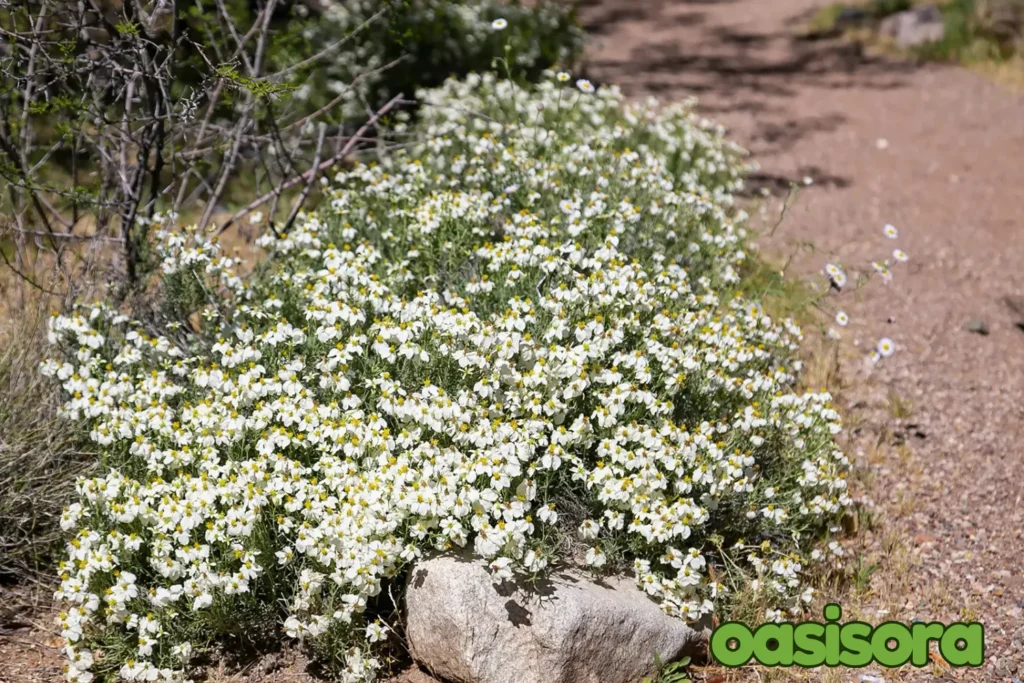
Desert Zinia
Do you want to decorate your yard with a lovely, low-maintenance plant?
Zinnia is perfect for you then! This small plant grows 4-8 inches tall and makes a thick carpet with tiny white flowers. It’s perfect for rocky areas, between big stones, or at the front of your garden.
When you plant many together, they make a stunning show.
Native to: Southwestern United States and Northern Mexico
Climate Regions: Cold semi-arid climate (BSk), Hot semi-arid climate (BSh), Hot desert climate (BWh)
USDA Zones: 7-10
Pros: This plant is super good at surviving with little water. It has lovely white flowers that resemble daisies and bloom for a long time, from spring to October.
These flowers make your yard a joyful place by drawing butterflies and native bees. Perfect for rocky areas and garden borders, adding a bright and cheerful touch.
Considerations: This plant takes its time to grow strong. It needs soil that drains water very well. In the first year, it might look a bit bare. Also, it can be hard to find this plant in most nurseries.
2. Desert Marigold (Baileya multiradiata)
AKA: Paper Daisy, Desert Baileya, Woolly Desert Marigold, and also Many-flowered Desert Marigold
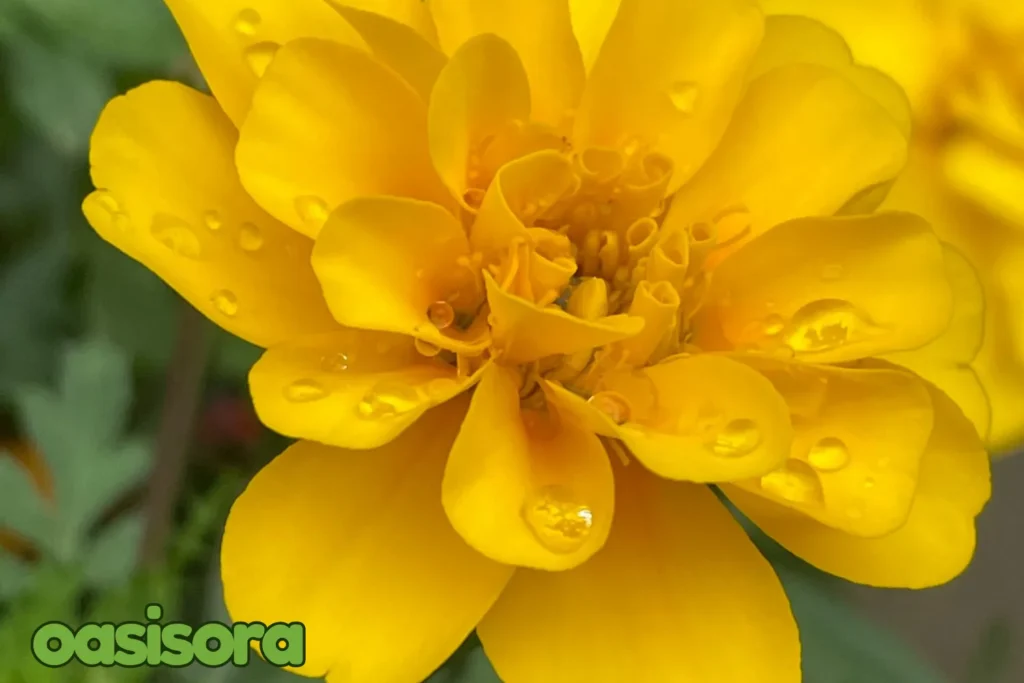
Desert Marigold
Add a burst of sunshine to your garden with this cute yellow native desert plant. This plant has bright yellow flowers on silver stems that create big patches of happy color.
It’s perfect for gardens that look like wildflower fields, natural areas, and desert meadows. You’ll love how it looks when you plant 3-5 of them together!
Native to: Mojave and Sonoran Deserts
Climate Regions: 1. Cold semi-arid (BSk), Hot semi-arid (BSh), and Hot desert (BWh)
USDA Zones: 7-11
Pros: It blooms almost all year in warm places, spreads easily by reseeding and makes a beautiful cut flower. Plus, it grows well in poor soil and can survive with little water once it’s established!
Considerations: It only lives for 2-3 years. When it’s not blooming, it can look messy. You might need to remove old flowers to stop them from spreading too much. And in very hot weather, it might go to sleep for a while!
3. Trailing Four O’Clock (Mirabilis multiflora)
AKA: Wild Four O’Clock, Giant Four O’Clock, Colorado Four O’Clock, and Many-flowered Four O’Clock
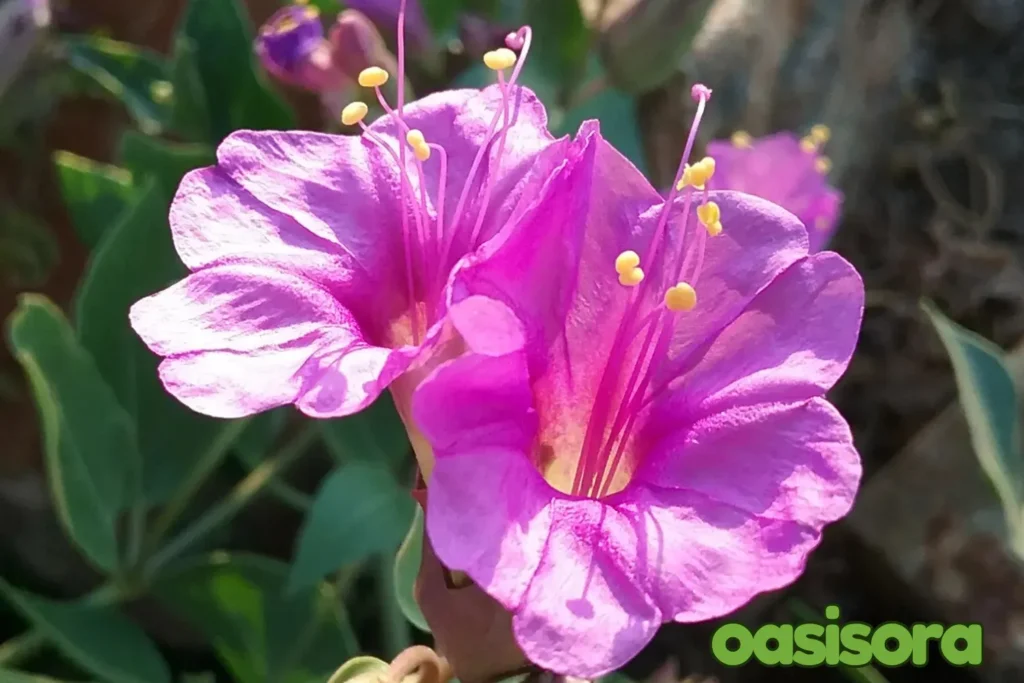
Mirabilis multiflora
This stunning plant can add a mystical touch to your garden’s evening. This Trailing Four O’Clock plant is a spreader with big, beautiful pink flowers that open late in the day. It’s flawless for your yard to give it a natural and wildlife roam.
Native to: Southwestern United States
Climate Regions: Hot semi-arid climate (BSh), BSk Cold semi-arid climate (BSk), and Cold desert climate (BWk)
USDA Zones: 5-9
Pros: This native desert plant has big, bright pink flowers that open in the late afternoon, and can endure periods of intense dryness. It is a lasting plant and draws unique visitors, like hummingbirds and sphinx moths. Plus, it can handle cold weather!
Considerations: It’s hard to move once it’s grown big. It sleeps during winter. The flowers close up during the day. And when you want to remove it, its deep roots can be tricky to get rid of.
4. Silver Ponyfoot (Dichondra argentea)
AKA: Silver Falls Dichondra, Silver Dichondra, and Kidney Weed
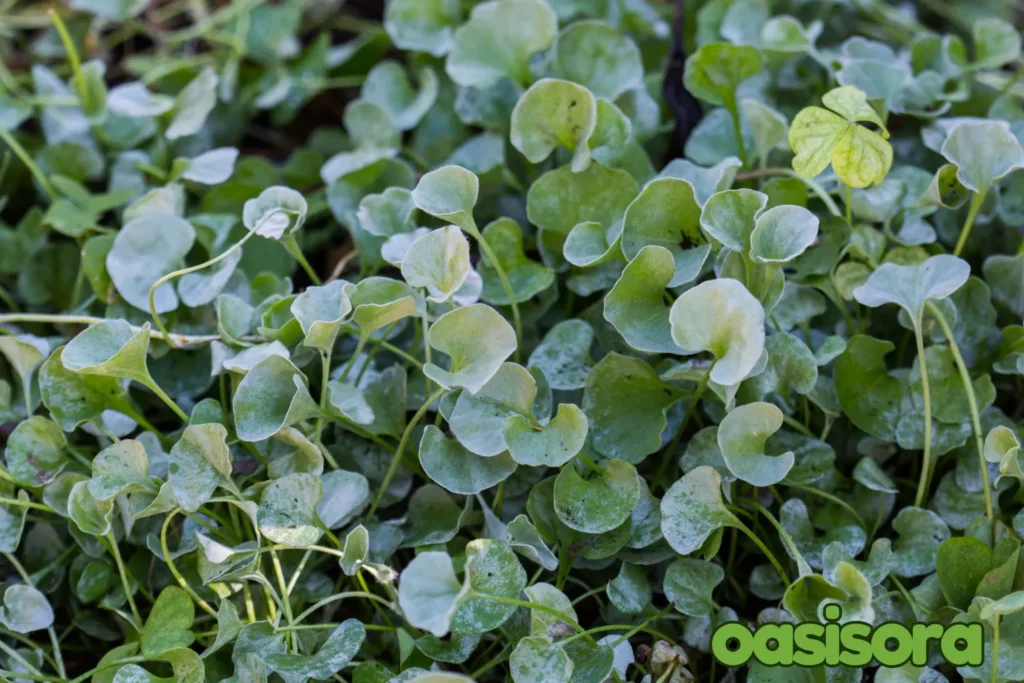
Silver Ponyfoot
Ever wished to give your garden a gleaming silvery touch?
Try this trailing ground cover. Beautiful white, yellow, and pink flowers adorn this shrub. It attracts butterflies and bees and blooms in sunny areas with good drainage!
Native to: Arizona, New Mexico, Texas, and Mexico
Climate Regions: Hot semi-arid climate (BSh) and Hot desert climate (BWh)
USDA Zones: 8-11
Pros: This plant has beautiful, shiny silver leaves that look great all year! It grows fast and covers the ground quickly. It’s perfect for areas between big stones, can handle people walking on it a little, and looks great in pots and hanging baskets.
Considerations: It needs more water than other plants from the same area. It can’t handle cold weather. If it likes where it’s growing, it might spread too much! And if this native desert plant gets too much desert sun, its leaves might get hurt!
5. Desert Primrose (Oenothera deltoides)
AKA: Birdcage Evening Primrose, Lion in a Cage, Devil’s Lantern, and Dune Evening Primrose.
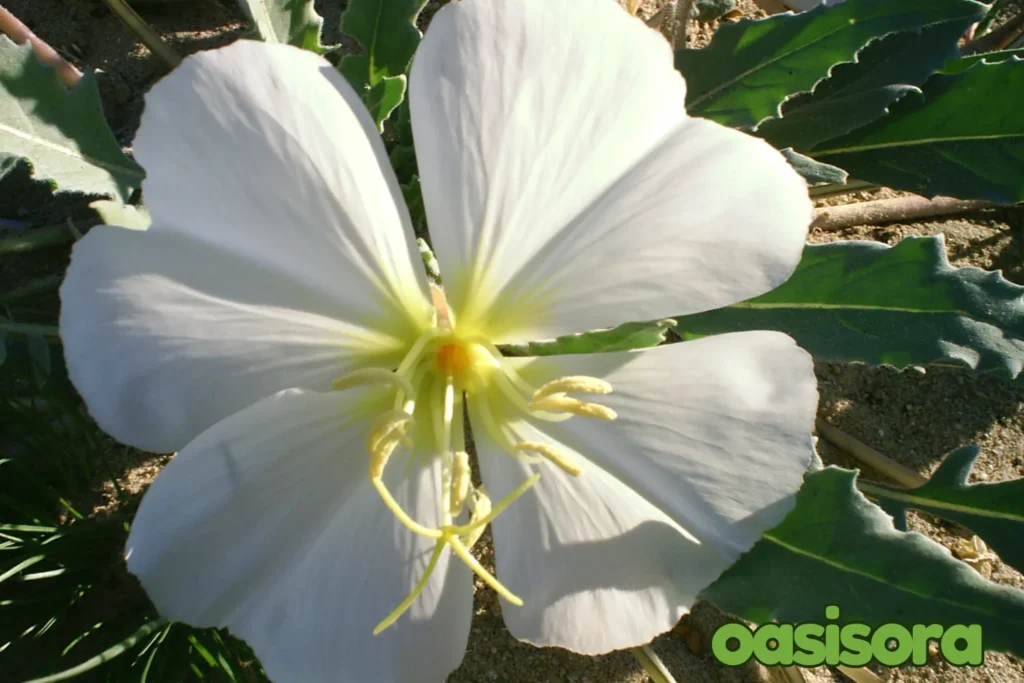
Desert Primrose
You must try desert primrose for a matchless beauty in your native desert plant yard! The gorgeous blossoms of this lovely shrub come in pink, yellow, and white hues.
It’s ideal for giving full-sun, well-draining soil regions a splash of color. It also draws pollinators like butterflies and bees.
Native to: California, Arizona, Nevada, and Utah
Climate Regions: Hot desert climate (BWh), and also Cold desert climate (BWk)
USDA Zones: 6-10
Pros: This plant has lovely, fragrant pink, yellow, and white flowers! It draws butterflies and bees to desert gardens and gives them color.
Considerations: It needs dry soil and lots of sunlight to bloom. It doesn’t like cold weather, so keep it warm! If it gets too much water, it might not bloom as well.
6. Desert Verbena (Glandularia gooddingii)
AKA: Southwestern Verbena, Goodding’s Verbena

Desert Verbana
With hairy stems and leaves, Desert Verbena is a great spreading native desert plant. It forms a low floor covering and has cheerful pink-purplish type flowers in clusters. The plant needs moisture to bloom and may flower throughout the year in some areas. This is not much drought-tolerant despite being grown in a desert environment.
However, it can be a superb addition to your oasis due to its vibrant flowers if you want to attract pollinators.
Native to: Southwestern United States and Mexico
Climate Regions: Hot desert climate
USDA Zones: 6-10
Pros: This plant has pretty, fragrant purple flowers that draw butterflies and other pollinators to desert gardens and give them a cute colour.
Considerations: Needs well-drained soil and plenty of sunlight to bloom. Can tolerate drought but may require occasional watering.
Flowering Desert Perennials
My folks! Now let’s jump to stunning desert perennials for your yard:
7. Penstemon (Penstemon pseudospectabilis)
AKA: Desert Penstemon, Mohave Beardtongue, and Mohave Penstemon
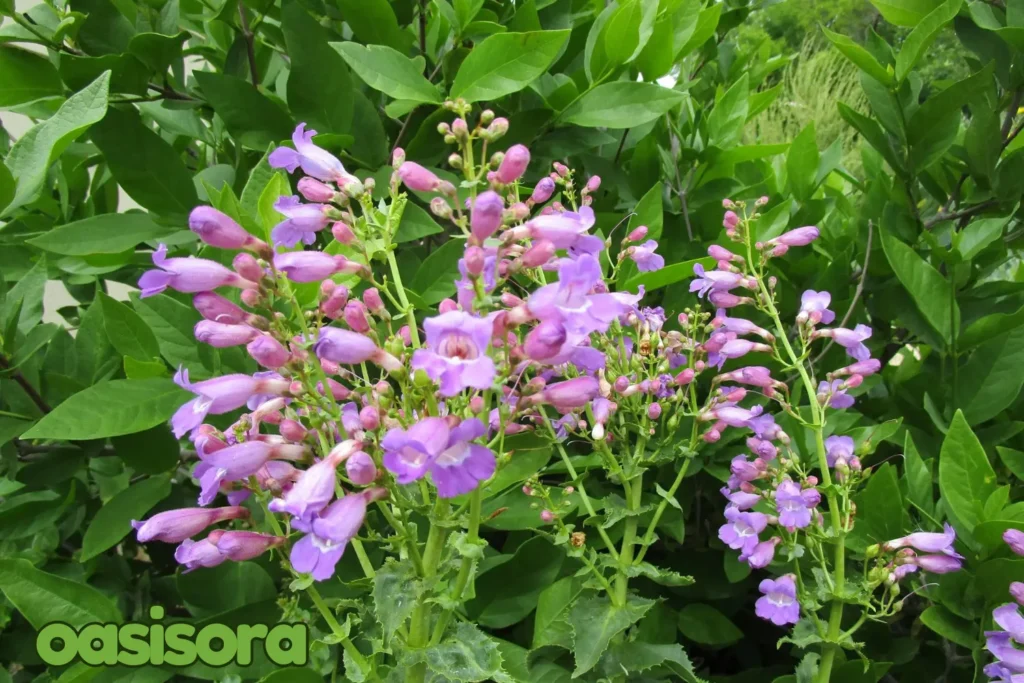
Penstemon
Attract butterflies, bees, and hummingbirds with this spectacular Penstemon! It’s a lovely flower that can withstand drought and comes in pink, purple, and white. It’s excellent for giving dry areas some color!
Native to: California, Arizona, Nevada, Utah, and Texas
Climate Regions: Hot desert climate (BWh) and Hot semi-arid climate (BSh)
USDA Zones: 6-10
Pros: This desert plant requires little water, blooms for a long time, and attracts butterflies and bees! It looks fantastic in natural settings and is also very easy to maintain.
Considerations: It might need protection from extreme winter cold. Also, it needs soil that drains well to keep it from being so much soggy.
8. Desert Lupine (Lupinus sparsiflorus)
AKA: Coulter’s Lupine, Mojave Lupine, and Loose-flowered Lupine
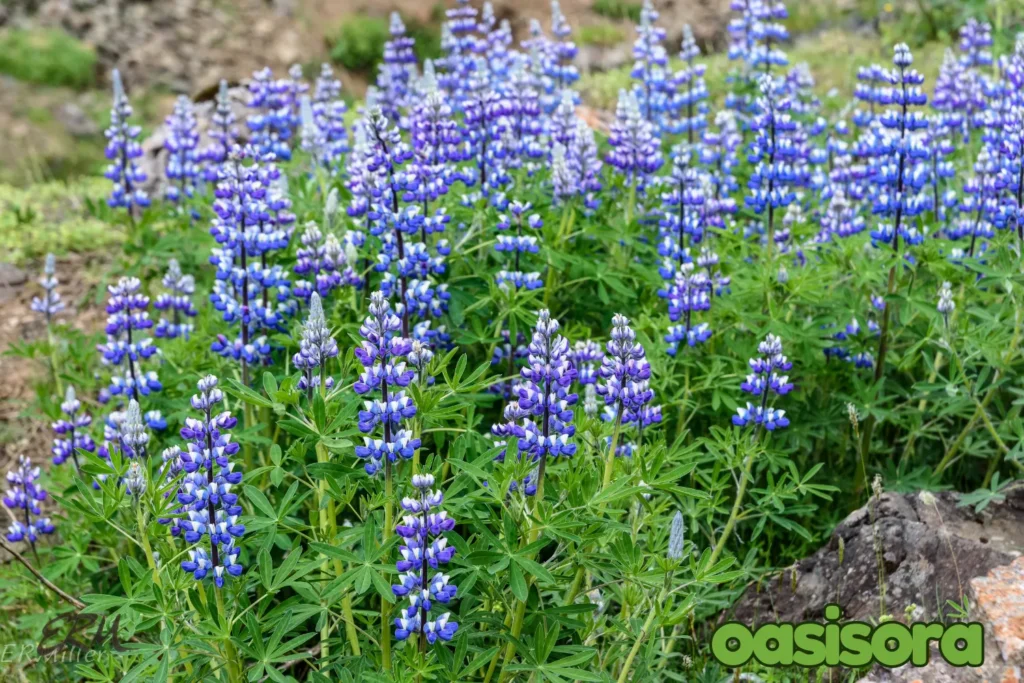
Desert Lupine
Desire to add a beautiful purple-blue carpet to your spring garden?
Try Desert Lupine! It creates stunning drifts of color in the spring. You can plant it in wildflower meadows, natural areas, or even new garden beds to improve the soil!
Native to: Mojave and Sonoran Deserts
Climate Regions: Hot semi-arid climate (BSh) and Hot desert climate (BWh)
USDA Zones: 4-10
Pros: This plant has gorgeous purple-blue flowers! It helps make the soil better, is great for wild areas, and attracts local bees. It also grows new plants from its seeds every year.
Considerations: This native desert plant lives for just one year. It needs winter rain to start growing. If it’s too dry, it might not bloom. It looks best when planted in big groups.
9. Desert Globemallow (Sphaeralcea ambigua)
AKA: Desert Hollyhock, Apricot MallowSore-eye Poppymallow, and Orange Globemallow
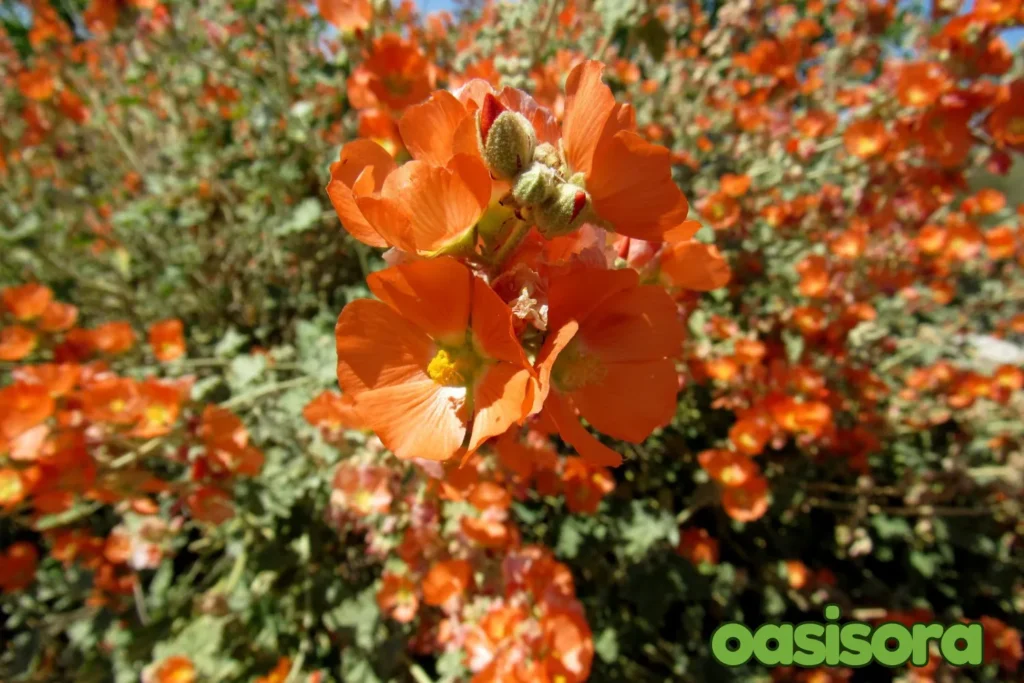
Desert Globemallow
This beautiful plant is for a burst of bright color to your garden. It has gray-green leaves and bright orange flowers that create stunning spots of color.
It’s perfect for natural gardens, butterfly gardens, and hot sunny spots.
Native Region: Southwestern United States to Southwestern Mexico
Climate Region: Cold desert climate (BWk), hot desert climate (BWh), Hot semi-arid climate (BSh), and also Cold semi-arid climate (BSk)
USDA Zones: 6-10
Pros: This plant blooms with orange flowers almost all year! It’s super good at handling drought, grows fast, and attracts local bees and butterflies. Its gray leaves add a nice contrast too!
Considerations: This plant might get a little leggy as it gets older. It spreads its seeds easily and might need trimming to keep its shape. Also, be careful when touching it, as its hair can irritate your skin.
10. Desert Sunflower (Geraea canescens)
AKA: Hairy Desert Sunflower, Desert Gold, and also Desert Geraea
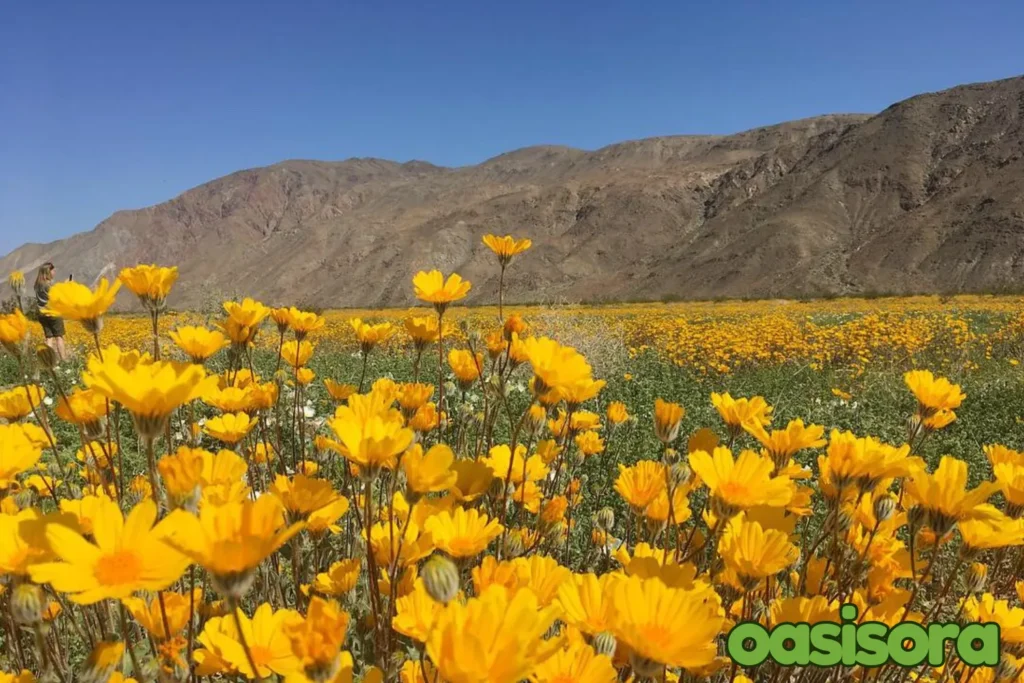
Desert Sunflower
Dears! Do you want to bring a smile to your garden with happy yellow flowers?
Try this bright plant! Its cheerful yellow flowers on branching stems are a treat for birds and pollinators. These native desert plants are flawless for wildflower gardens, natural areas, and bird-friendly gardens.
Native Region: Mojave and Sonoran Deserts
Climate Region: Hot desert climate (BWh), and Hot semi-arid climate (BSh)
USDA Zones: 7-10
Pros: This plant has super bright yellow flowers! It grows quickly, is drought-tolerant, draws bees and birds, and is a wonderful cut flower.
Considerations: This plant spreads swiftly and has a short lifespan. It needs room to grow naturally. When it gets too hot, it goes to sleep.
11. Chocolate Flower (Berlandiera lyrata)
AKA: Green Eyes, Chocolate Daisy, and Lyre-leaf Greeneyes
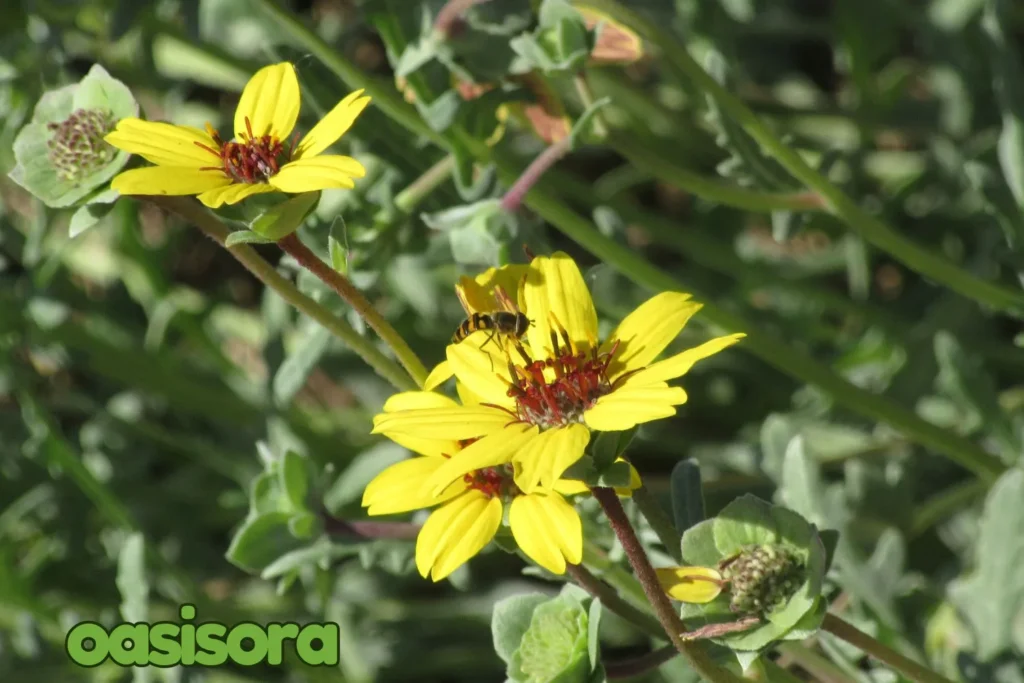
Chocolate Flower
Wake up to a sweet chocolate scent in your garden with this yummy-smelling flower! Its beautiful yellow, daisy-like flowers smell like morning chocolate.
They look fantastic around patios, in sensory gardens, and in butterfly gardens.
Native Region: Southwestern United States to Central Mexico
Climate Region: Cold semi-arid climate (BSk), Hot semi-arid climate (BSh), and Hot desert climate (BWh)
USDA Zones: 5-10
Pros: This flower smells like chocolate! It blooms for a long time, attracts butterflies, can handle drought, and stays strong in cold weather!
Considerations: This flower spreads its seeds easily. It blooms only in the morning, can look messy, and might need to be separated every few years!
12. Fairy Duster (Calliandra eriophylla)
AKA: Powder Puff Plant, False mesquite, and Pink mimosa
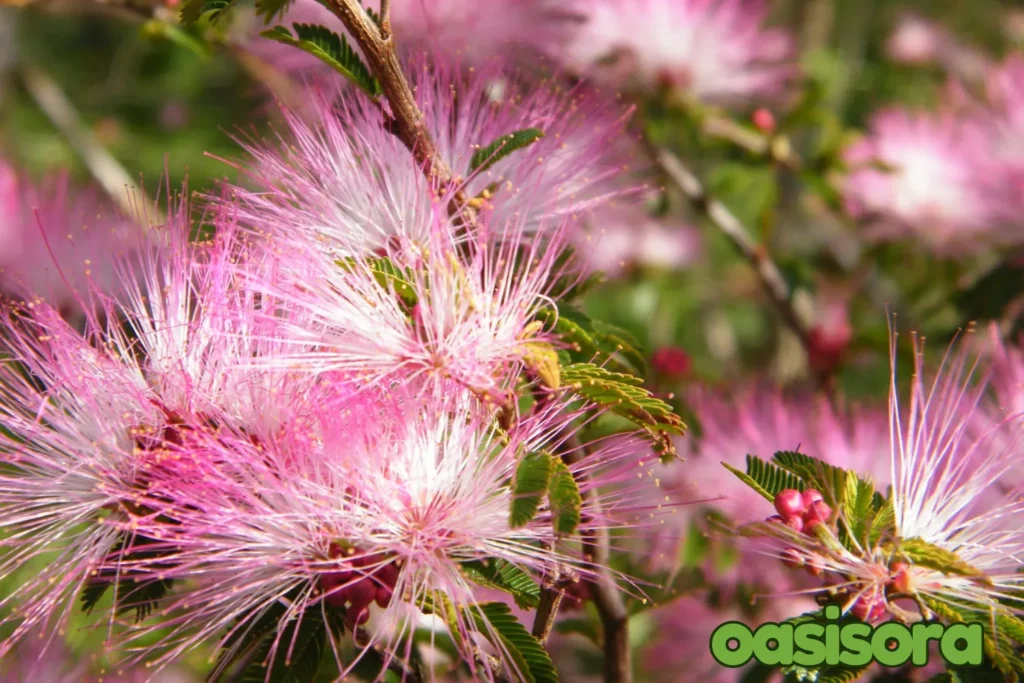
Fairy Duster
Try this enchanting Fairy Duster in your native desert plant yard for a unique sparkle!
This shrub is pretty and doesn’t need much water. It has fun, pink flowers that look like pom-poms! It’s great for desert gardens or pots.
Native to: Southwestern United States and northern Mexico
Climate Regions: Hot desert climate (BWh) and Hot semi-arid climate (BSh)
USDA Zones: 8-11
Pros: This plant attracts pollinators, has long-lasting blooms, and is incredibly drought-tolerant! It is also deer-resistant, low-maintenance, and looks great in natural gardens.
Considerations: It might need protection from extreme winter cold. It likes dry soil, so don’t overwater! Cutting it back helps it stay shaped and grow new flowers.
13. Desert Beardtongue (Penstemon parryi)
AKA: Mohave Beardtongue, and Mohave Penstemon
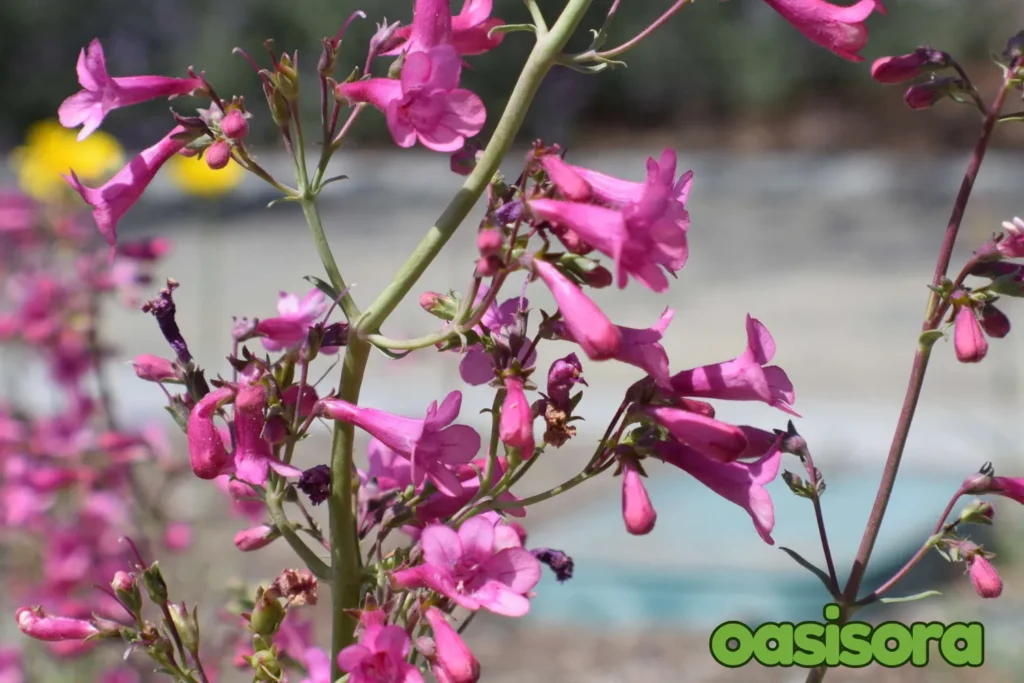
Desert Beardtongue
Do you want a beautiful flower to draw hummingbirds to your garden?
Hummingbirds love this lovely native desert plant, which grows 2-4 feet tall and has vivid pink flowers! It’s great for hot, sunny spots, wildlife gardens, and rock gardens. Planting many together creates a big visual impact.
You’ll get beautiful spring flowers and more blooms with enough water.
Native to: Sonoran Desert, Mojave Desert
Climate Regions: Hot desert climate (BWh), and Hot semi-arid climate (BSh)
USDA Zones: 7-10
Pros: This plant has bright pink, tube-shaped flowers that hummingbirds adore! It blooms for a long time, can handle drought, and deer don’t like to eat it!
Considerations: This plant needs soil that drains well. If the soil is too heavy, it might not live long.
It might need a little extra water when it’s blooming. And if it gets too hot in the summer, it needs some shade in the afternoon!.
14. Desert Ruellia (Ruellia peninsularis)
AKA: Baja Ruellia
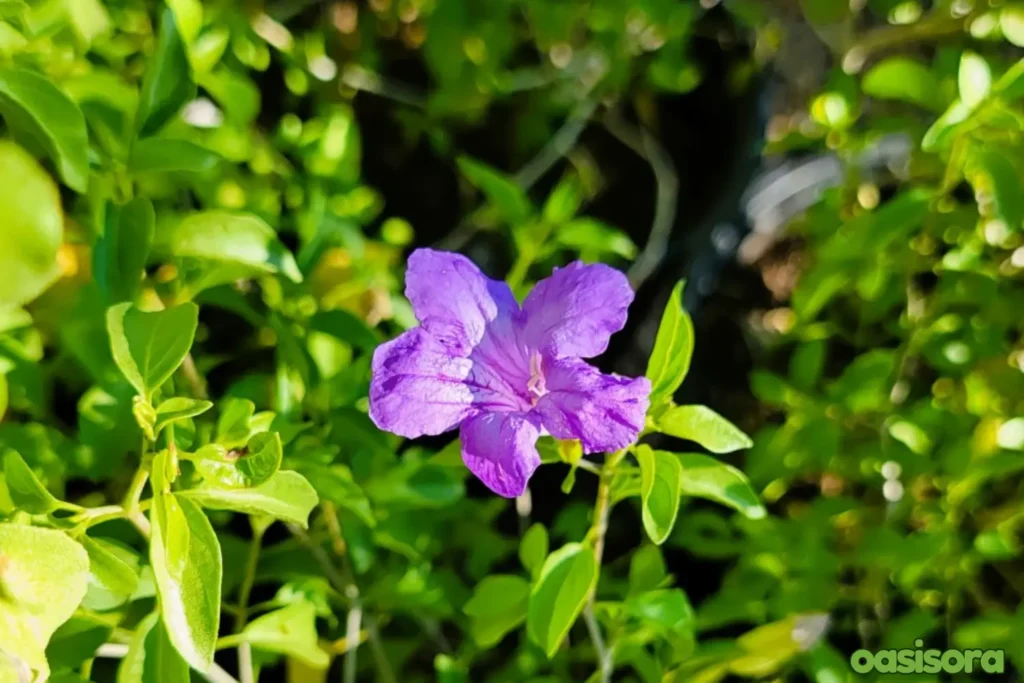
Desert Ruellia
Desert Ruellia is really a gorgeous plant, having glossy leaves and purplish colored nice flowers that usually bloom in late spring or summer to attract perky pollinators. This plant grows up to roundly 3 to 4 feet tall and 6 feet wide. To keep it healthy, you can prune damaged parts in early spring. You can also grow new plants from its seeds or root cuttings in summer.
With good care, it can bring a vibrant color and beauty to your garden.
Native to: Southwestern US or Mexico
Climate Regions: Hot desert climate
USDA Zones: 8-11
Pros: Attracts butterflies or other pollinators, adds beauty to the oasis, needs well-drained soil, and a sufficient amount of sunlight.
Considerations: it usually needs regular watering, shelter from frost, and pruning of damaged foliage.
Native Shrubs and Accent Plants
Get ready to add some classy finish to your yards with these striking shrubs and accent desert plants:
15. Brittlebush (Encelia farinosa)
AKA: Incienso, White Brittlebush, Desert Gold, and also the Golden Hills
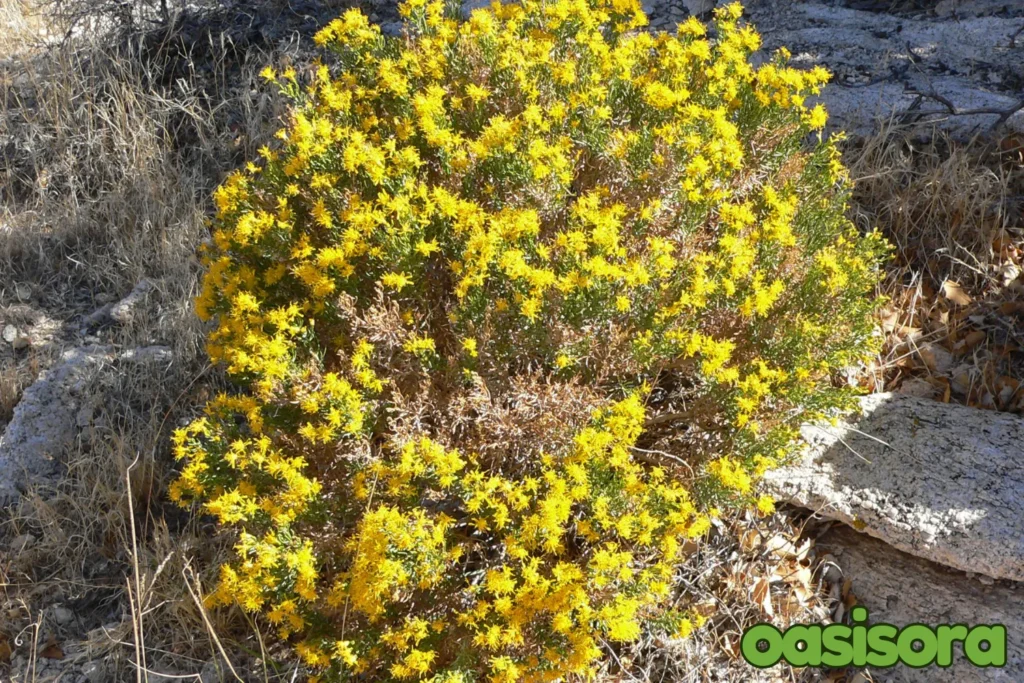
Brittlebush
Enhance your yard with a burst of sunshine to your garden with this amazing shrub!
It has beautiful silver leaves and lots of bright yellow, daisy-like flowers. You’ll love it for slopes, big groups, or natural desert gardens!
Native Region: Sonoran and Mojave Deserts
Climate Region: Hot semi-arid climate (BSh) and Hot desert climate (BWh)
USDA Zones: 8-11
Pros: This plant shines bright! It has happy yellow flowers and silver leaves all year. It grows fast, survives with little water, and is perfect for slopes!
Considerations: This plant has a short life, so it needs regular trimming. It can look messy in summer and might die back in very cold weather.
16. Apache Plume (Fallugia paradoxa)
AKA: Ponil, False Feather, and Bridal Wreath
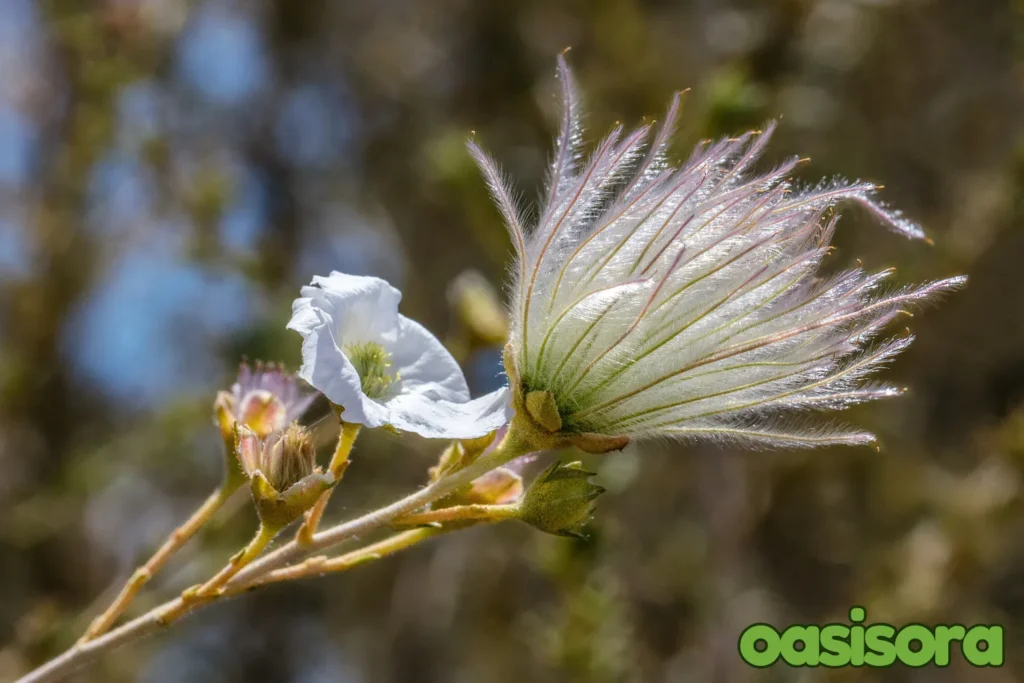
Apache Plume
Want to invite birds and colorful butterflies to your yard? Plant this amazing native desert plant! It’s a semi-evergreen with beautiful white flowers and fancy, feathered seeds. You’ll love it for natural fences, wildlife gardens, and year-round beauty!
“Also, consider adding some desert trees that provide great shade to create cool spots and enhance your garden’s charm.”
Native Region: Southwestern United States
Climate Region: Hot semi-arid climate (BSh), Cold semi-arid climate (BSk), and Cold desert climate (BWk)
USDA Zones: 4-10
Pros: This plant is a beauty! It has big white flowers, then fuzzy pink seeds. It’s super strong in cold weather, survives with little water, and blooms for a long time.
Considerations: This plant can look messy if not trimmed. It might spread seeds everywhere! It needs room to breathe and takes time to settle in.
17. Creosote Bush (Larrea tridentata)
AKA: Chaparral, Greasewood, Hediondilla, and also the Gobernadora
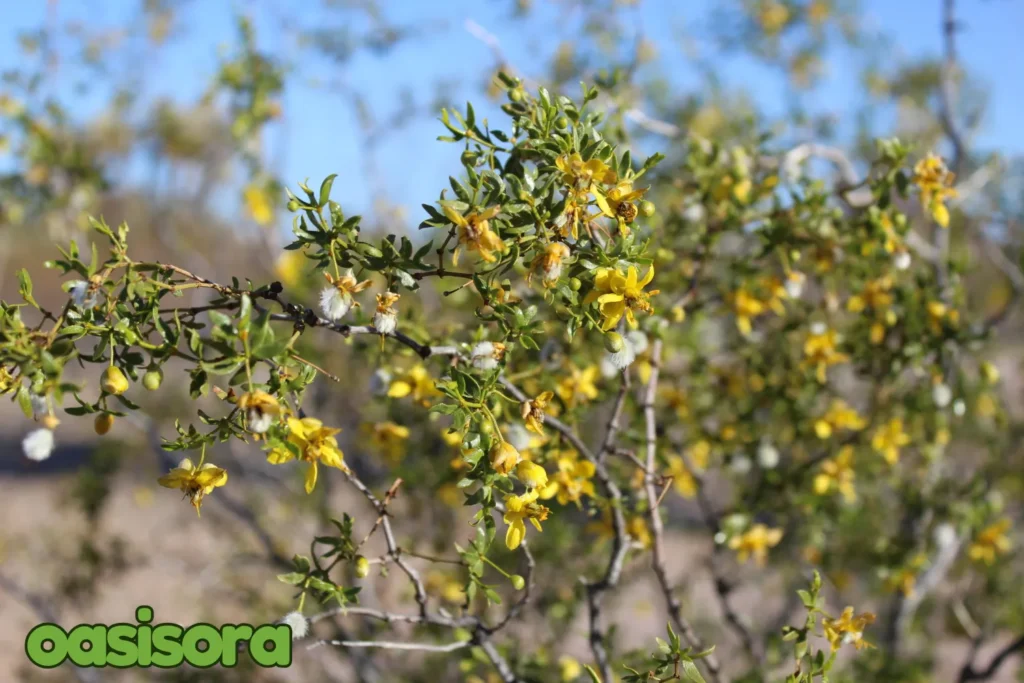
Creosote Bush
This old desert shrub has small yellow flowers and smells nice after rain. It’s great for desert gardens and helps wildlife.
Native Region: Chihuahuan, Southwestern United States, Sonoran, Mojave Deserts
Climate Region: Cold desert climate (BWk), Hot semi-arid climate (BSh), and Hot desert climate (BWh)
USDA Zones: 7-11
Pros: It survives with very little water, smells amazing after rain, and keeps its green leaves year-round. It lives a long time and provides a safe home for wildlife!
Considerations: This native desert plant grows slowly and needs lots of space. It can also keep other plants from growing nearby. Be careful not to overwater, or it might look thin and sparse.
18. Jojoba (Simmondsia chinensis)
AKA: Wild Hazel, Goat Nut, Deer Nut, Coffee Berry, and Pig Nut
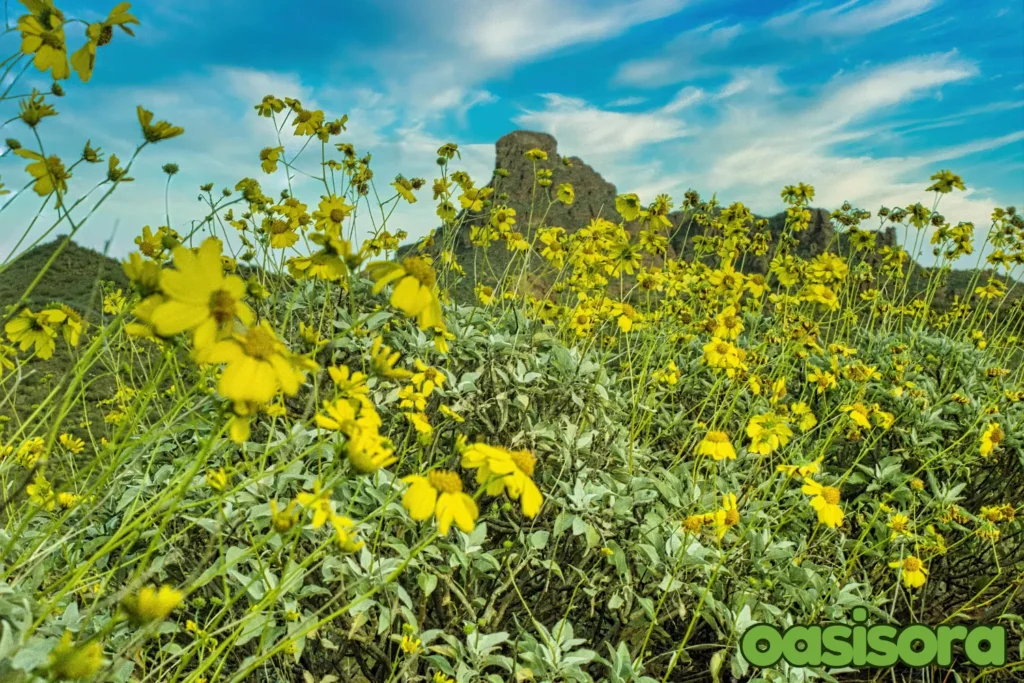
Jojoba
If you desire a shrub that’s ideal for privacy and wildlife. Then, this remarkable evergreen is for you! It has thick, gray-green leaves and is excellent for use as yard hedges, screens, and wildlife gardens.
Plus, it’s an important plant for farmers, making it a cool teaching tool!
Native Region: Sonoran Desert
Climate Region: Hot semi-arid climate (BSh) and Hot desert climate (BWh)
USDA Zones: 8-11
Pros: This plant is amazing! It’s always green, survives with very little water, and deer don’t like it. It lives a long time and helps animals with food and a home.
Considerations: This plant grows slowly, needs a friend to make berries, and can get big. Its leaves are also super sharp, so be careful.
19. Desert Lavender (Condea emoryi)
AKA: Purple Desert Lavender and Emory’s Lavender
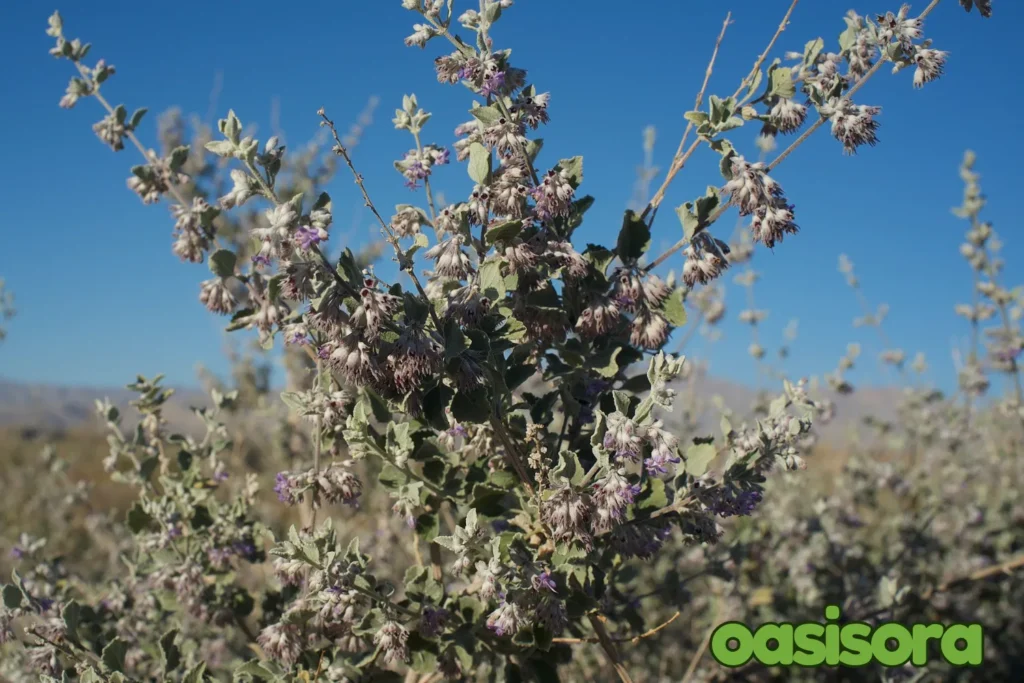
Desert Lavender
Do you love the calming scent of lavender?
This amazing shrub has aromatic silver leaves and stunning purple flowers! It’s perfect for sensory gardens, butterfly gardens, and desert herb gardens.
Native Region: Sonoran Desert
Climate Region: Hot semi-arid climate (BSh) and Hot desert climate (BWh)
USDA Zones: 8-11
Pros: This native desert plant smells amazing like lavender! It has pretty purple flowers that bees and butterflies love. It’s also super tough, grows fast, and smells wonderful.
Considerations: It doesn’t like frost, needs well-draining soil, and can get a little messy if not trimmed. It might also get damaged in very cold winters.
20. Wolfberry (Lycium pallidum)
AKA: Pale Wolfberry and Pale Desert-Thorn
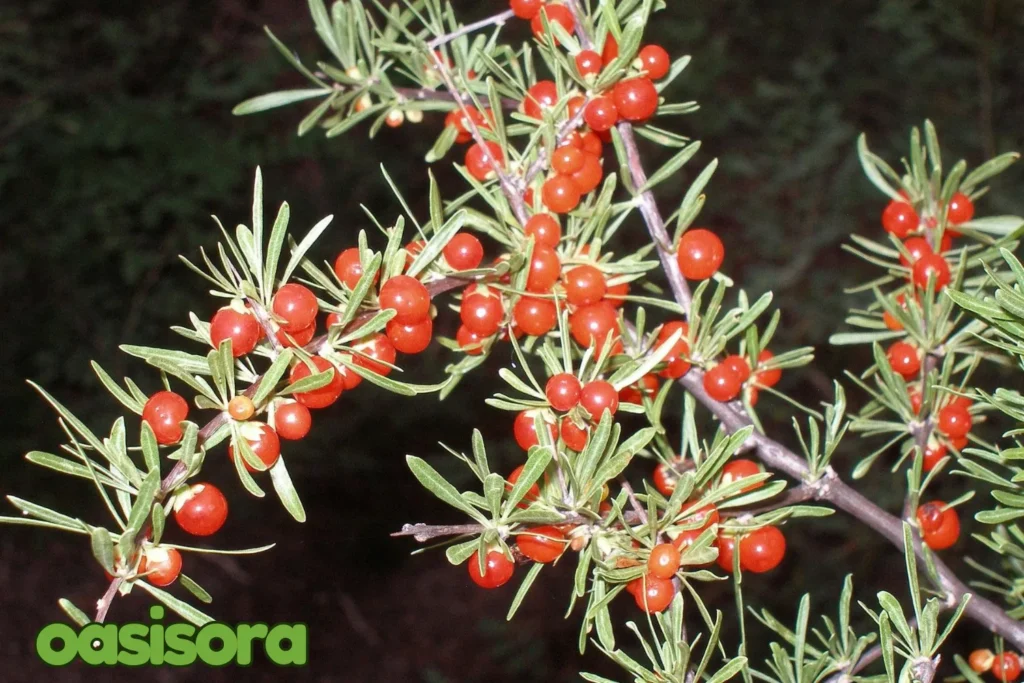
Wolfberry
Want to discover a desert superhero?
This unusual shrub has tiny green leaves and prickly branches! It yields delicious red berries that birds adore, as well as purple blossoms that draw butterflies and bees.
It is ideal for animal habitats. it’s a great addition to any garden featuring desert trees or plants.
Native Region: Southwestern United States and Northern Mexico
Climate Region: Hot desert climate (BWh)
USDA Zones: 5-9
Pros: This tough native desert plant is great for security hedges, attracts pollinators, and produces delicious berries!
Considerations: It has sharp thorns, needs well-draining soil, and can get messy if not trimmed. It’s also sensitive to frost.
21. Desert Willow (Chilopsis linearis)
AKA: bow Willow, Flowering Willow, and Willowleaf Catalpa
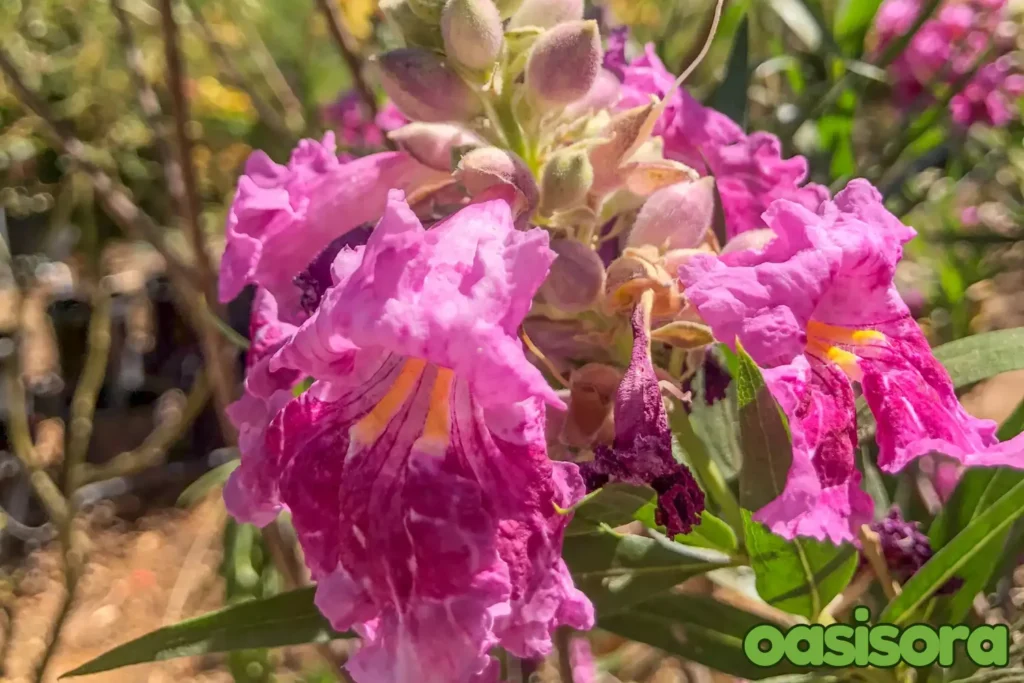
Desert Willow
Do you dream of a tree that adds stunning beauty to your yard?
Then, for sure, this wonderful tree is ideal! It features lovely, aromatic flowers and long, thin branches! It boasts trumpet-shaped flowers to attract bees, butterflies, and also hummingbirds.
It is ideal for attractive landscapes, wildlife habitats, and desert gardening.
Native Region: Southwestern United States and Northern Mexico
Climate Region: Hot desert climate (BWh)
USDA Zones: 6-10
Pros: This magnificent tree offers shade, pollinator attraction, and beautiful blossoms!
Considerations: It can be untidy, needs soil that drains well, and might need to be pruned frequently.
22. Texas Sage (Leucophyllum frutescens)
AKA: Texas Ranger, Purple Sage, Cenizo
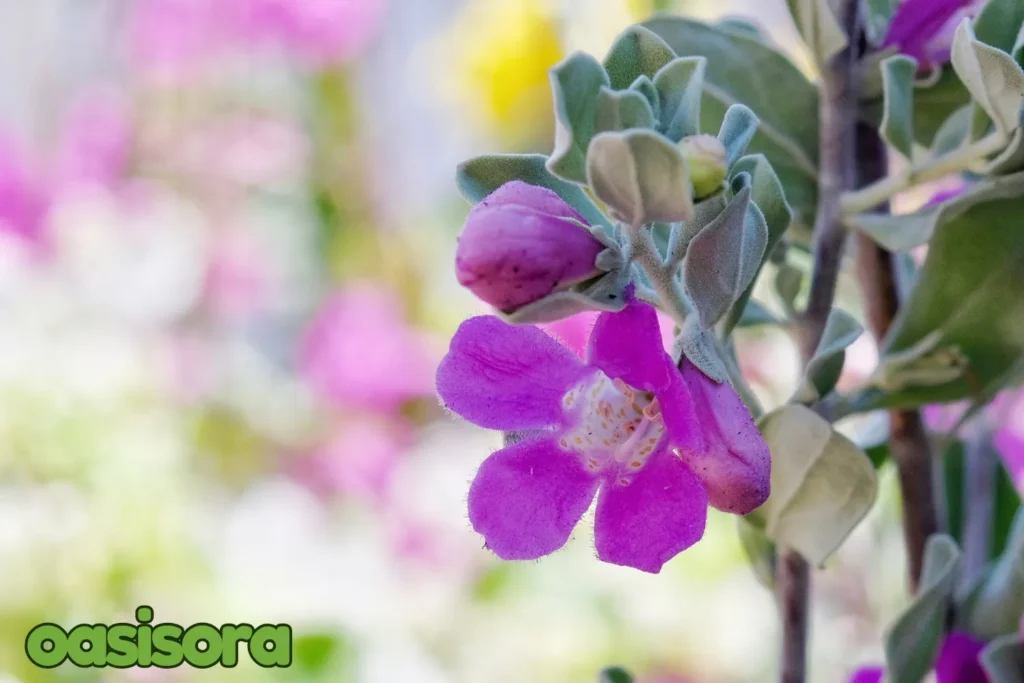
Texas Sage
Texas Sage is an awesome pick for your native desert plant gardens. It has silvery-grey leaves and pretty purple flowers that bloom all year. Plus, it’s super easy to care for and can handle dry spots and bad soil. It’ll superbly add some exceptional charm to your outdoor space without requiring much work.
Native to: Texas and Mexico
Climate Regions: Hot desert climate
USDA Zones: 7-10
Pros: Pretty purplish flowers, captures butterflies and pollinators, great for desert gardens.
Considerations: Requires well-drained soil, good sunlight, tolerates drought, or occasional watering may be needed.
Native Cacti and Succulents
Let’s discover all about the succulents and cactus plants for your native desert plant yard:
23. Hedgehog Cactus (Echinocereus spp.)
AKA: Calico Cactus, Strawberry Cactus, and Rainbow Cactus (species dependent)
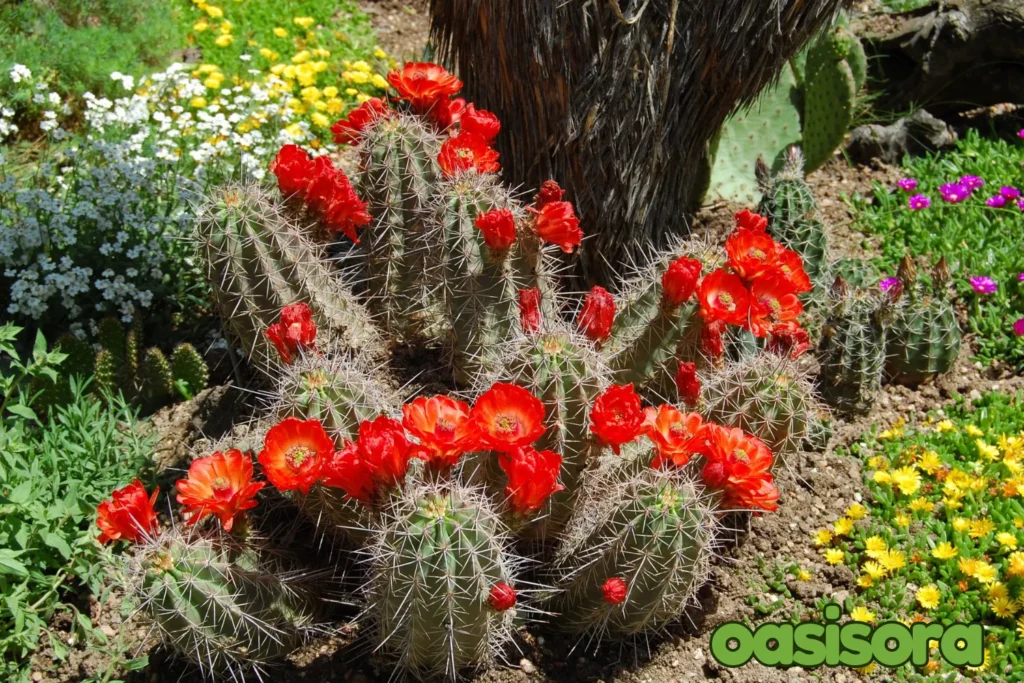
Hedgehog Cactus
You’ll love this tiny, clustering cactus! It comes in many varieties, each with vibrant spring flowers. Perfect for rock gardens, containers, and small desert gardens.
Native Region: Southwestern United States
Climate Region: Cold desert climate (BWk), Hot desert climate (BWh), Cold semi-arid climate (BSk), and Hot semi-arid climate (BSh)
USDA Zones: 5-10
Pros: It blooms with beautiful flowers in spring, can handle cold weather, grows in clusters, and is super easy to grow! Ideal for small spaces.
Considerations: Its sharp spines need special placement. It may require protection from intense afternoon sunlight, grows slowly, and hates excessive winter water.
24. Fishhook Barrel Cactus (Ferocactus wislizeni)
AKA: Arizona Barrel Cactus, Southwest Barrel Cactus, and Candy Barrel Cactus
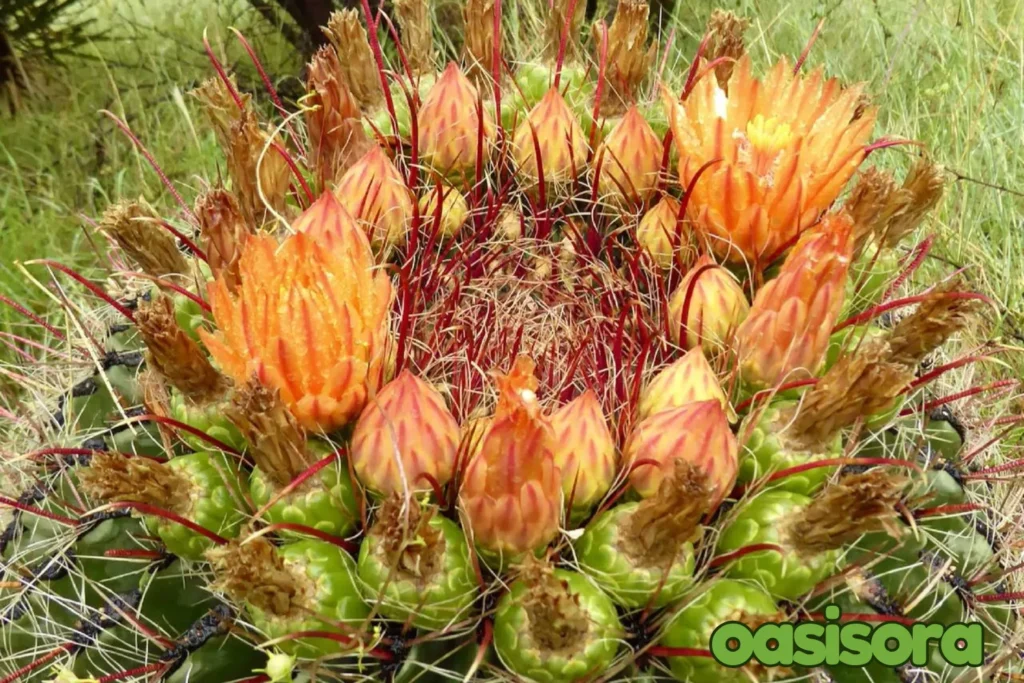
Fishhook Barrel Cactus
Want a cactus that’s a real head-turner?
Try it! This big, round cactus is cool! It has hooked spines and looks great in rock garden designs.
Native Region: Southwestern United States and Northern Mexico
Climate Region: Hot desert climate (BWh) and Hot semi-arid climate (BSh)
USDA Zones: 8-11
Pros: This remarkable cactus features cool curving spines, vivid yellow-red flowers, and a distinctive design! It also has a long lifespan and is extremely drought-tolerant.
Considerations: Be careful with this prickly friend. It has sharp spines, grows very slowly, requires shelter from the afternoon sun when young, and can fall over as it ages.
25. Buckhorn Cholla (Cylindropuntia acanthocarpa)
AKA: Deer Horn Cactus, Golden Cholla, and Major Cholla
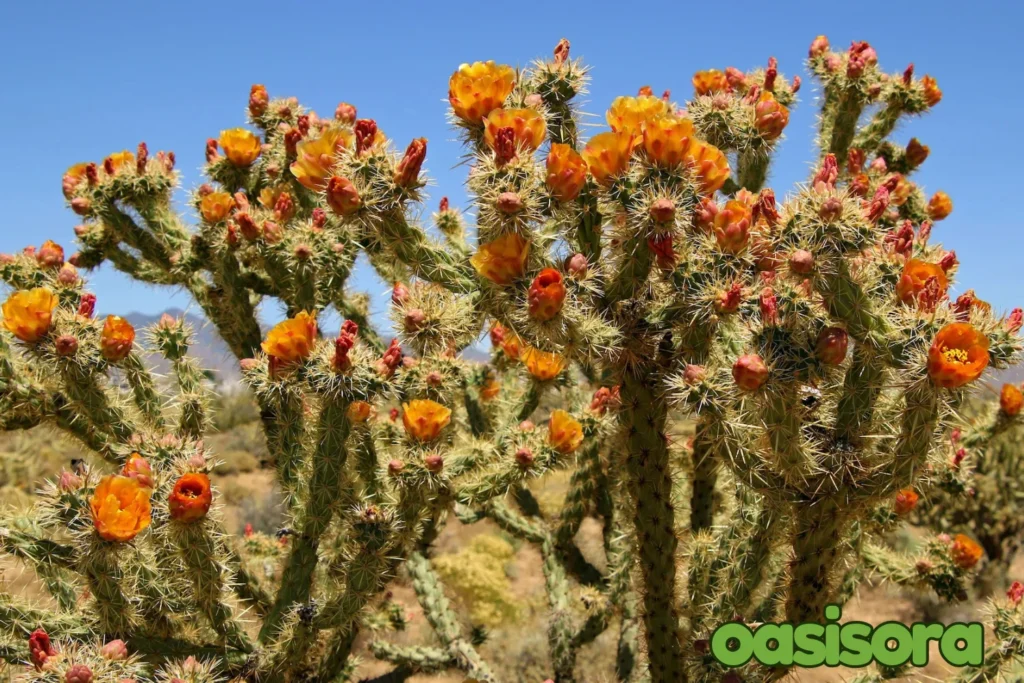
Buckhorn Cholla
Buckhorn Cholla is a real natural protector native desert plant. This branching cactus has bright golden spines and stunning orange-red flowers. Perfect for secure gardens, wildlife habitats, and natural landscapes!
Native Region: Mojave, Sonoran Deserts
Climate Region: Hot desert climate (BWh), and Hot semi-arid climate (BSh)
USDA Zones: 8-11
Pros: You’ll adore this amazing tree! It has a unique branch structure, and stunning spring flowers, and provides a cozy home for birds. Plus, it shines beautifully in the evening light.
Considerations: You’ll need to be careful around its super sharp spines! Its segments fall off easily, so give it lots of space. And, it can spread quickly when segments fall on the ground.
26. Banana Yucca (Yucca baccata)
AKA: Spanish bayonet, Blue Yucca, and Datil Yucca
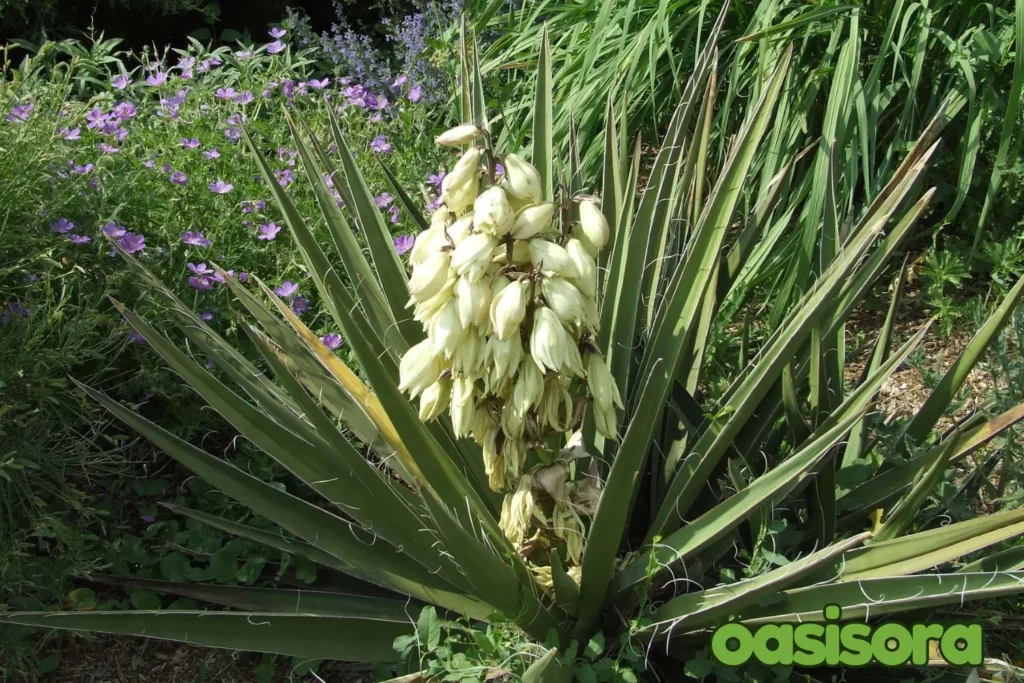
Banana Yucca
Make a style statement with this striking accent plant!
It has bold blue-green leaves and tall flower spikes that create a dramatic look. Perfect for eye-catching gardens and sustainable food gardens.
Native Region: Southwestern United States
Climate Region: Cold semi-arid climate (BSk), Cold desert climate (BWk), and also Hot semi-arid climate (BSh)
USDA Zones: 5-10
Pros: It has dramatic white flower stalks, and yummy edible fruits, and can survive with very little water. Plus, it stays green all year and has a unique, architectural shape.
Considerations: You’ll need to place it thoughtfully because of its sharp leaf tips. It grows slowly, gets big, and is hard to remove once it’s settled in.
27. Desert Spoon (Dasylirion wheeleri)
AKA: Spoon Flower, Wheeler Sotol, and Common Sotol
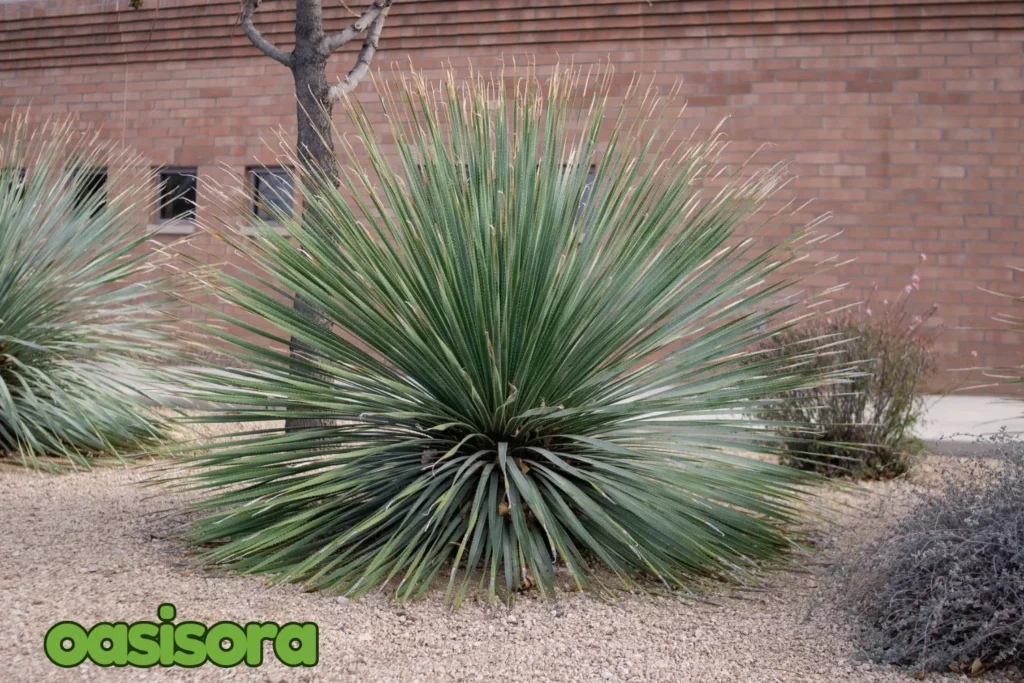
Desert Spoon
Are you in awe of a plant that makes your garden stand out?
Try this then! You’ll love this accent native desert plant! It has beautiful, symmetrical blue-gray leaves that look like a work of art. Also, it’s great for your modern yards, and rock gardens, and making a big impact!
Native Region: Sonoran Desert and Chihuahuan Desert
Climate Region: Hot desert climate (BWh), Hot semi-arid climate (BSh), and Cold semi-arid climate (BSk)
USDA Zones: 7-11
Pros: This plant has a cool shape, can survive with very little water, repels deer, stays green year-round, and lives for a long time.
Considerations: This cactus grows slowly, needs space, and rarely blooms.
28. Arizona Queen of the Night (Peniocereus greggii)
AKA: Nightblooming Cereus, Deer-horn cactus, and Reina De La Noche.
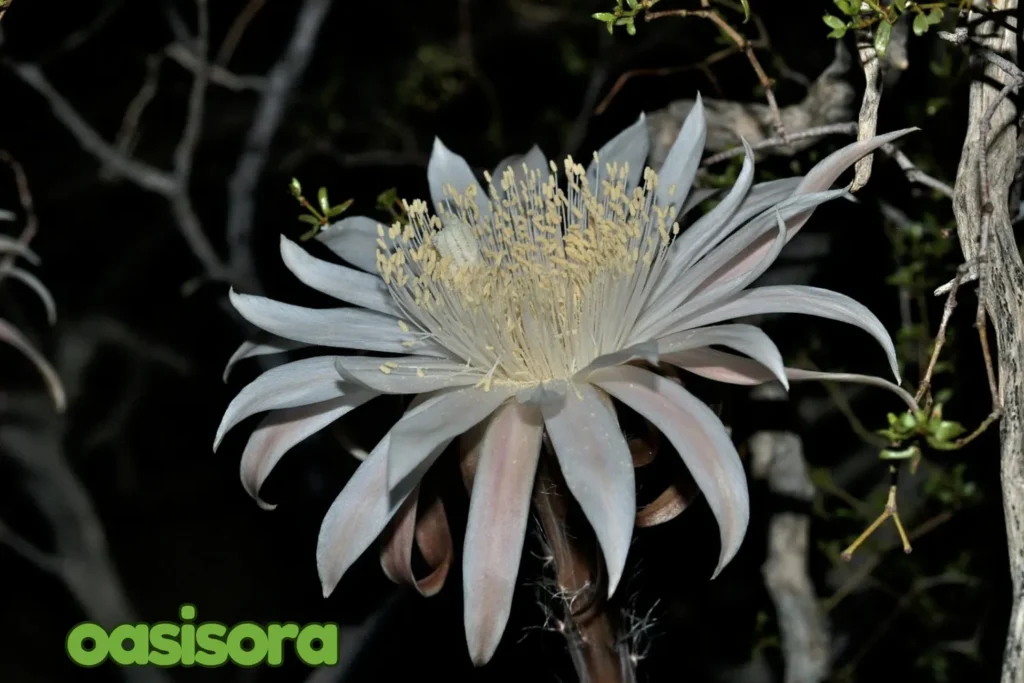
Arizona Queen of the Night
Isn’t “Queen of the Night” the coolest name for a plant?
I love the name of this native desert plant personally. This cactus has beautiful 34 white flowers that only bloom at night, attracting bats and moths. It’s perfect for unique landscapes and desert gardens!
Native Region: Sonoran Desert and Chihuahuan Desert
Climate Region: Hot desert climate (BWh), Hot semi-arid climate (BSh), and Cold semi-arid climate (BSk)
USDA Zones: 7-11
Pros: It has a distinctive architectural design, can exist for a long time with almost little water, boasts deer-repelling properties, and offers year-round greenness.
Considerations: It requires space to show off its shape, grows slowly, and blooms only sometimes.
29. Organ Pipe Cactus (Stenocereus thurberi)
AKA: Pitahaya Dulce, Pitaya Dulce, or Pitahaya de Mayo
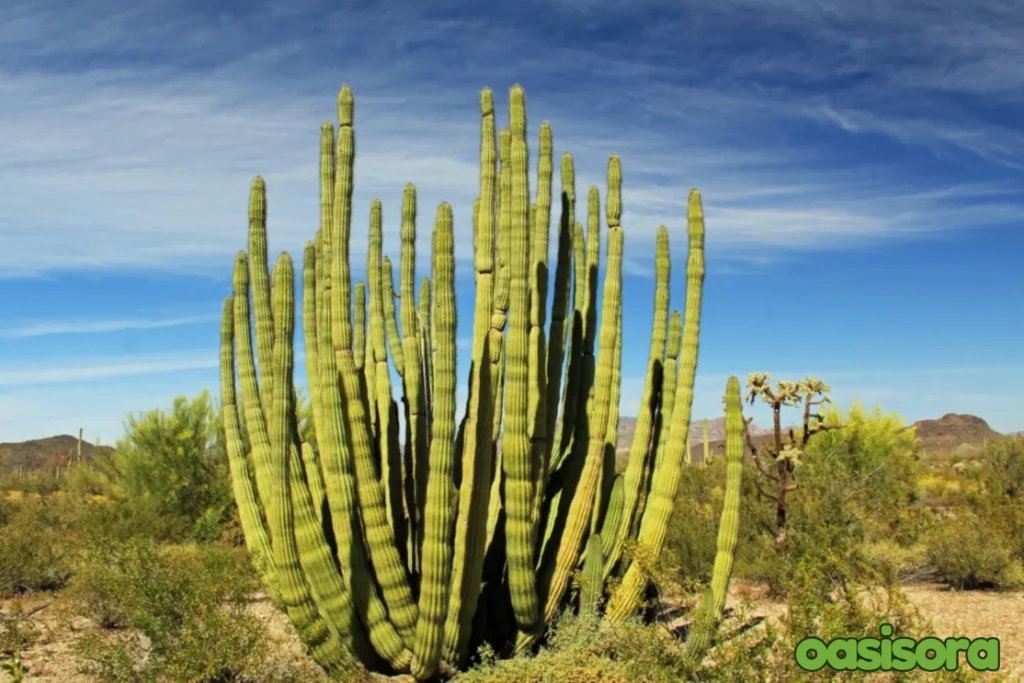
Organ Pipe Cactus
The Organ Pipe Cactus is an excellent native desert plant in the desert gardens. It has slender and tall stems that usually grow in clusters, giving it a nice look. The green to bluish-green color further adds to its appeal. Folks! What’s impressive about it? It is how long it lives and how well it handles tough desert conditions. It’s a very good choice for adding a dramatic touch to your overall landscape.
Native to: The Sonoran Desert in Mexico and Arizona
Climate Regions: Hot desert climate
USDA Zones: 9-11
Pros: This plant has beautiful flowers and a unique shape, adding beauty to desert gardens.
Considerations: Needs protection from frost and well-drained soil to thrive. May require occasional watering.
Architectural Statement Plants
Get ready to wow with these architectural wonders:
30. Saguaro Cactus (Carnegiea gigantea)
AKA: Giant Cactus, Giant Saguaro, and Sahuaro
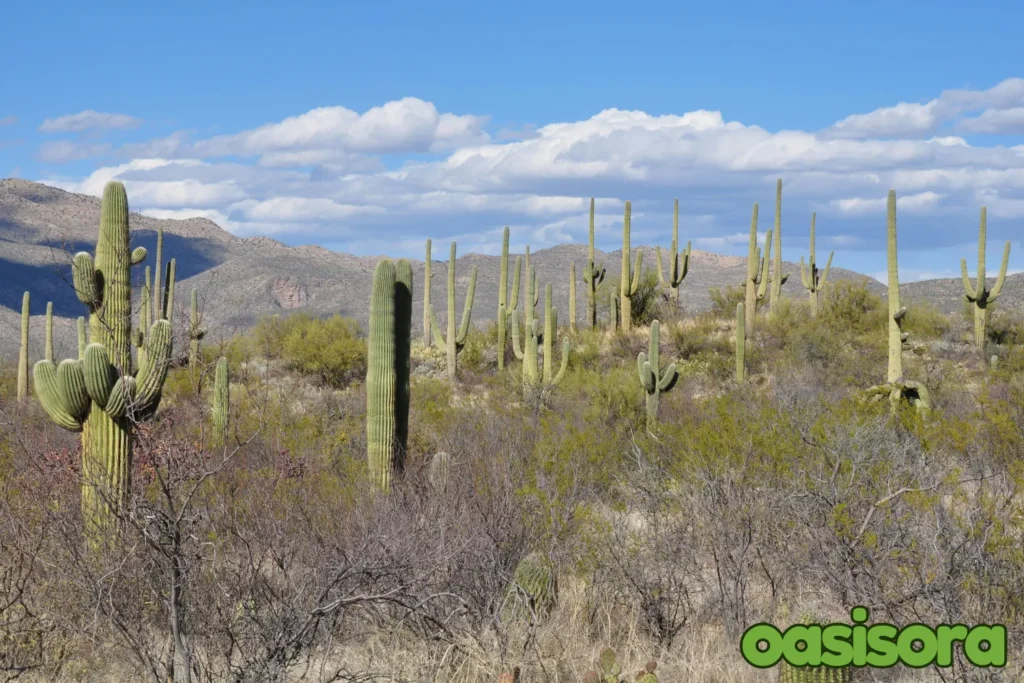
Saguaro Cactus
Meet the majestic Saguaro! With a lifespan of more than 150 years, this famous cactus is a symbol of the Sonoran Desert. This desert plant is perfect for:
- Restoring Desert Areas
- Historic Gardens
- Special Landscape Projects.
Native Region: Sonoran Desert
Climate Region: Hot desert climate (BWh) and also Hot semi-arid climate (BSh)
USDA Zones: 8-11
Pros: You’ll love its iconic desert look, super long lifespan, and role in helping wildlife thrive! It grows into a dramatic shape, and blooms with gorgeous white flowers at night.
Considerations: This plant grows slowly and can be too difficult to find or buy. It’s also sensitive to frost.
31. Ocotillo (Fouquieria splendens)
AKA: Coachwhip, Vine Cactus, Desert Coral, and Jacob’s Staff
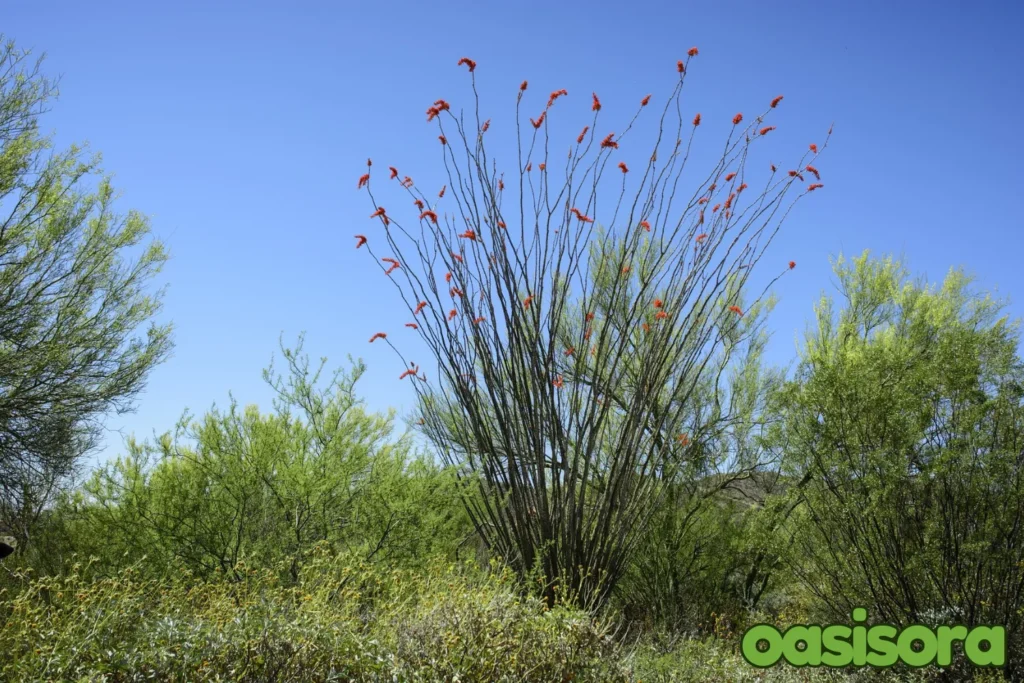
Ocotillo
Ocotillo has striking spiny stems, seasonal leaves, and show-stopping bright red flower clusters.
This plant is great for attracting animals, adding a unique style, and keeping unwanted visitors out.
Native Region: Chihuahuan and Sonoran Deserts
Climate Region: Hot desert climate (BWh), Hot semi-arid climate (BSh), and Cold desert climate (BWk)
USDA Zones: 8-11
Pros: This native desert plant has a one-of-a-kind sculptural shape, vibrant red flower spikes, and speedy leaf growth after rain! It’s a hummingbird magnet and creates a dramatic silhouette.
Considerations: This cactus needs room to grow, has sharp points, and is hard to move. It takes time to look its best and drops leaves when it’s dry.
32. Blue Palo Verde (Parkinsonia florida)
AKA: Green Stick, Yellow Paloverde
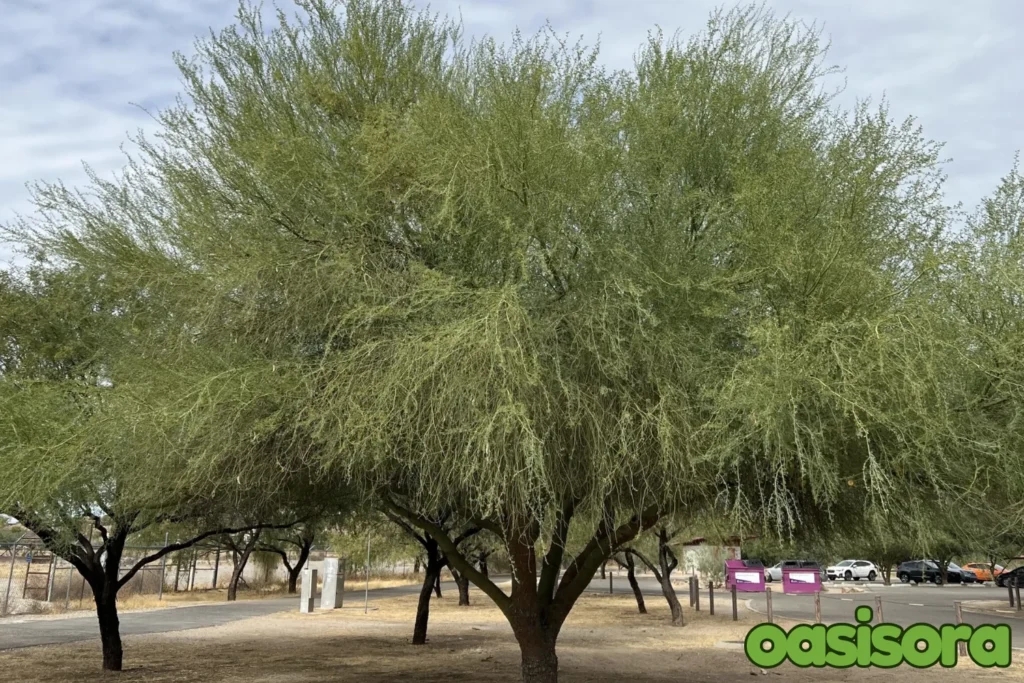
Blue Palo Verde
Want a tree that brings instant charm?
Try this Blue Palo Verde! This desert tree grows quickly and has beautiful blue-green bark and bright yellow spring blossoms. Perfect for adding quick shade, creating desert oases, and attracting wildlife.
Native Region: Sonoran Desert
Climate Region: Hot desert climate (BWh), and Hot semi-arid climate (BSh)
USDA Zones: 8-11
Pros: Palo Verde is known for its brilliant yellow spring blossoms, gorgeous blue-green stems and bark, quick growth rate, and filtered shade. It’s also evergreen and drought-tolerant.
Considerations: This native desert plant has thorny branches, sheds lots of leaves, and its surface roots can damage paving. Plus, it doesn’t live as long as Ironwood.
33. Ironwood Tree (Olneya tesota)
AKA: Desert Ironwood or Palo Fierro
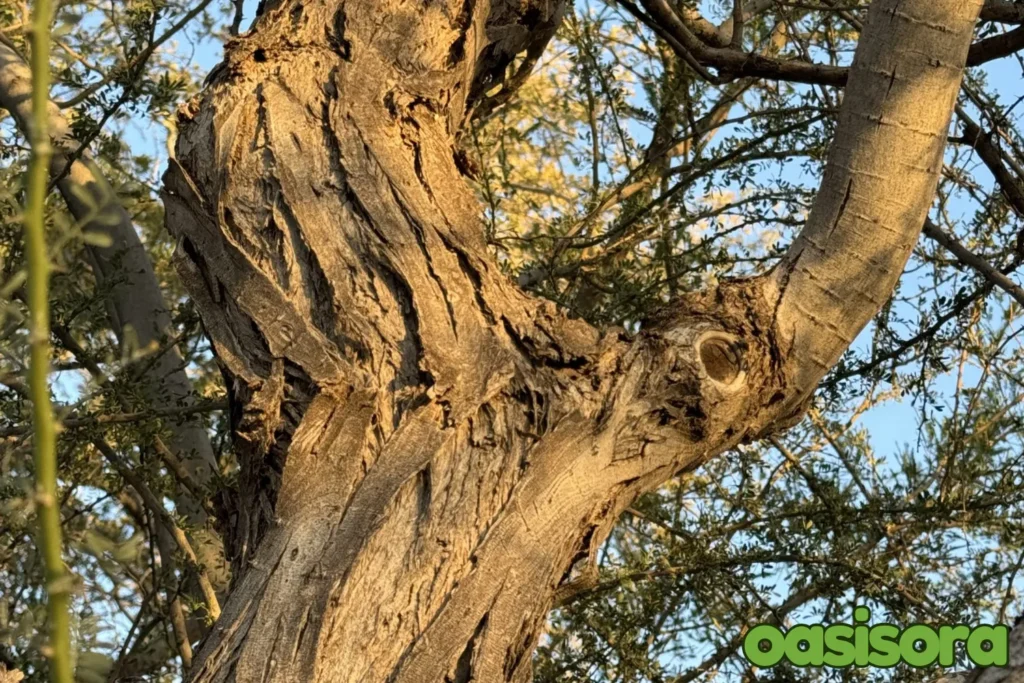
Ironwood Tree
Consider desert ironwood if you need a tough and stylish native desert plant in your oasis. It’s a beautiful, drought-tolerant tree, desert ironwood adds resilience and beauty to desert environments all year round.
Native Region: Sonoran Desert
Climate Region: Hot Desert (BWh), Hot Semi-Arid (BSh)
USDA Zones: 9-11
Pros: This tree offers lovely perks, like magnificent flowers, and sturdy wood, and is drought tolerant.
Considerations: Ironwood Tree has a slow growth rate and is sensitive to frost, plus it requires full sun.
34. Joshua Tree (Yucca brevifolia)
AKA: Yucca Palm, Tree Yucca, and Palm Tree Yucca
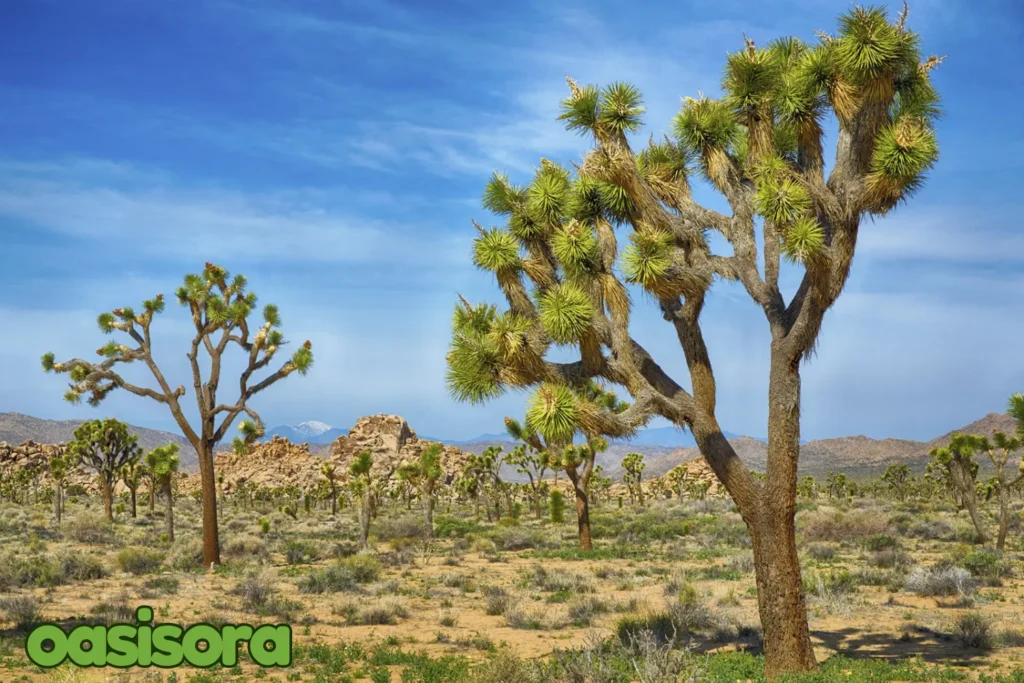
Joshua Tree
You can also try the Joshua tree. It’s a desert icon! This unique tree thrives in hot deserts. Its thick trunk and spiky leaves can add a dramatic touch to your outdoor setting.
Native Region: Mojave Desert
Climate Region: Hot Desert (BWh), Cold Desert (BWk)
USDA Zones: 6-10
Pros: This tree produces beautiful flowers, is easy to care for, and can handle drought.
Considerations: Remember that it grows slowly, has sharp points, and needs direct sunlight.
How to Incorporate Native Desert Plants Into Your Landscape
Hey, now let’s learn how to add amazing native desert plants to your yard for beautiful, low-maintenance landscaping that saves water:
1. Designing with Native Plants
Want to create a beautiful desert garden? Here are some tips:
- Group plants by height to create a visually appealing landscape. Giant plants should go in the back, and shorter plants in the front of the yard.
- Pick the plants with alike water requirements to make maintenance easier for you. Cacti and succulents are perfect for super dry areas.
- Select plants with different bloom colors to add vibrant colors to your garden. Desert marigolds, lupines, and ocotillo are stunning options.
2. Xeriscaping Basics
Xeriscaping is a great way to save water in your desert garden. Here’s how:
- Place plants with high water needs in low-lying areas to collect rainwater. It’s like a natural irrigation system.
- To stop weeds and lower evaporation, use gravel and rocks. This option saves water and is easy to care for.
- To prevent water from collecting near your home, design your garden to slope downward away from the house. It’s a smart and safe choice!
3. Container Gardening Options
Want to bring native desert plants to your patio or small space? Here are some options:
- Choose compact plants like agave, echeveria, or crassula that thrive in containers. They’re flawless for small spaces!
- Select plants with similar soil needs to make maintenance easier. Cacti and succulents love well-draining soil.
- Use large containers to create a dramatic display of native desert plants. It’s a beautiful way to add desert charm to your patio.
Care and Maintenance for Native Desert Plants
Hey! Here are some tips and tactics that I recommend you follow for a flawless desert yard effortlessly:
Soil Preparation
Native desert plants love well-draining soil! To create the perfect soil, you can mix in some organic matter like compost or mulch. This helps water drain quickly and prevents root rot. Your plants will thank you seriously if you follow this tip!
Watering Guidelines
Watering the desert plants is easy my folks! During the first year, water them regularly to help them establish strong roots. Then, depending on the weather, reduce watering to once or twice a month. Even though they endure drought, they still require your love and care.
Seasonal Maintenance
Generally, the desert plants need a little TLC throughout the year. In spring, prune dead stems and fertilize lightly. In summer, protect them from extreme heat with some shade. In the fall, reduce watering and pruning. And in winter, enjoy their beautiful winter blooms.
The Ecological Benefits of Native Desert Plants
- The Native desert plants are like superheroes for the environment!
- These plants help local animals like birds, butterflies, and bees by giving them food and a home.
- Using desert plants is also eco-friendly too. Because they:
- Keep the soil in place with their deep roots.
- Need less water because they’re drought-tolerant. This sustainability will help our planet of course!
- of the largest desert plants, growing up to 70 feet tall!
Final Thoughts
Embrace the Beauty of the Desert
Transform your yard into a stunning desert oasis! Growing local desert plants is easy and amazing. They:
- Need almost no upkeep.
- Use less water.
- Attract awesome local animals.
- Thrive in hot desert conditions.
Choose from 34 incredible options and create a vibrant garden! Start with a few plants that love local weather and watch them grow beautifully.
My friends, desert gardening can be easy! By picking plants that are native to the desert, you’re letting nature do the work for you. So why not give it a try? Your garden—and the planet—will thank you!
Want more desert gardening ideas? Check out our post on desert landscapes to learn how to create a beautiful and eco-friendly outdoor space using native desert plants!
FAQs
1. What kind of plants live in the desert?
Some plants thrive ideally in the desert, including:
Cacti
Succulents
Drought-tolerant trees like Palo Verde and Ironwood.
2. What is the best desert plant?
The saguaro cactus is regarded as the best native desert plant.
3. Which is the best example of a desert plant?
With its unique shape and durability, the Joshua tree is an iconic and best example of a desert plant.
4. What is the largest plant in the desert?
The Giant Saguaro Cactus is one.

6 thoughts on “34 Native Desert Plants for Beautiful Landscapes in 2025”
Comments are closed.